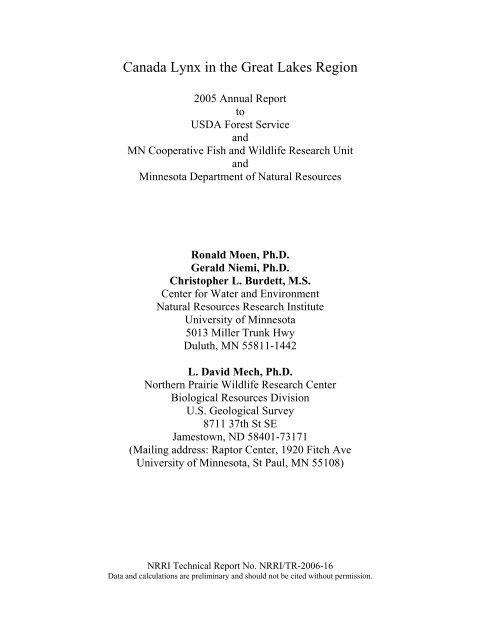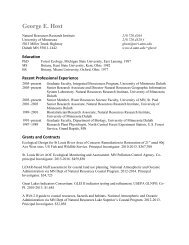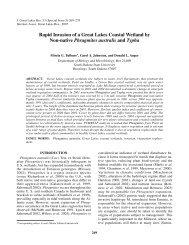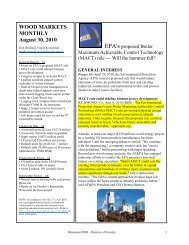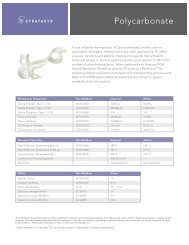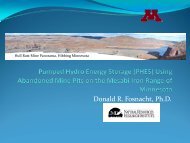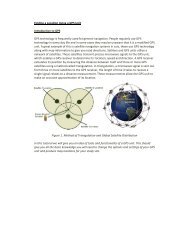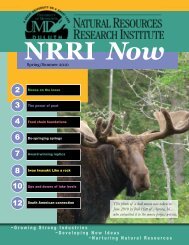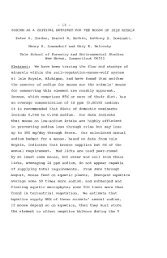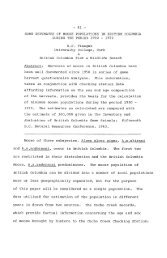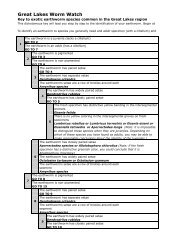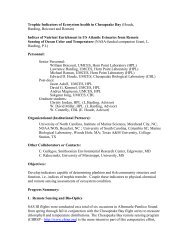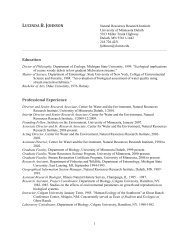Canada Lynx in the Great Lakes Region - Minnesota Department of ...
Canada Lynx in the Great Lakes Region - Minnesota Department of ...
Canada Lynx in the Great Lakes Region - Minnesota Department of ...
Create successful ePaper yourself
Turn your PDF publications into a flip-book with our unique Google optimized e-Paper software.
<strong>Canada</strong> <strong>Lynx</strong> <strong>in</strong> <strong>the</strong> <strong>Great</strong> <strong>Lakes</strong> <strong>Region</strong>2005 Annual ReporttoUSDA Forest ServiceandMN Cooperative Fish and Wildlife Research UnitandM<strong>in</strong>nesota <strong>Department</strong> <strong>of</strong> Natural ResourcesRonald Moen, Ph.D.Gerald Niemi, Ph.D.Christopher L. Burdett, M.S.Center for Water and EnvironmentNatural Resources Research InstituteUniversity <strong>of</strong> M<strong>in</strong>nesota5013 Miller Trunk HwyDuluth, MN 55811-1442L. David Mech, Ph.D.Nor<strong>the</strong>rn Prairie Wildlife Research CenterBiological Resources DivisionU.S. Geological Survey8711 37th St SEJamestown, ND 58401-73171(Mail<strong>in</strong>g address: Raptor Center, 1920 Fitch AveUniversity <strong>of</strong> M<strong>in</strong>nesota, St Paul, MN 55108)NRRI Technical Report No. NRRI/TR-2006-16Data and calculations are prelim<strong>in</strong>ary and should not be cited without permission.
<strong>Canada</strong> <strong>Lynx</strong> <strong>in</strong> <strong>the</strong> <strong>Great</strong> <strong>Lakes</strong> <strong>Region</strong> 2005 Annual ReportExecutive SummaryWe summarize <strong>the</strong> third year <strong>of</strong> a project on <strong>Canada</strong> lynx ecology <strong>in</strong> <strong>the</strong> <strong>Great</strong> <strong>Lakes</strong> region.The project is designed to address four major questions about this population <strong>of</strong> <strong>Canada</strong> lynx:distribution, habitat use, abundance, and persistence. In <strong>the</strong> first 33 months <strong>of</strong> this project wecaptured and deployed radiotelemetry collars on 32 <strong>Canada</strong> lynx. Each animal was locatedapproximately biweekly after be<strong>in</strong>g collared when logistically feasible.GPS collars have been deployed on 12 <strong>of</strong> <strong>the</strong> lynx <strong>in</strong> this project. Over 12,000 locations wereobta<strong>in</strong>ed from GPS collars at <strong>the</strong> end <strong>of</strong> 2005. GPS collar locations will be fundamental tounderstand<strong>in</strong>g movements and habitat use <strong>of</strong> <strong>Canada</strong> lynx. Ambient temperature and animal activitylevel is recorded by <strong>the</strong> collars <strong>in</strong>dicat<strong>in</strong>g daily patterns <strong>in</strong> activity, and also shows how active ananimal was when each GPS location was obta<strong>in</strong>ed.Radiocollared females have had kittens <strong>in</strong> 2004 and 2005, and at least 5 <strong>of</strong> <strong>the</strong> 12 kittensknown from den visits <strong>in</strong> 2005 survived until December 2005. Of <strong>the</strong> 2004 litters, 1 and possibly 2<strong>of</strong> <strong>the</strong> known <strong>of</strong>fspr<strong>in</strong>g were alive at <strong>the</strong> end <strong>of</strong> 2005. Of <strong>the</strong> 32 lynx radiocollared by December 31,2005, 2 died <strong>in</strong> 2003 and no animals were recovered dead <strong>in</strong> 2004. We recorded <strong>the</strong> deaths <strong>of</strong> 14radiocollared animals <strong>in</strong> 2005, one <strong>of</strong> which had died <strong>in</strong> 2004.We f<strong>in</strong>ished <strong>the</strong> third year <strong>of</strong> surveys for snowshoe hare, <strong>the</strong> major prey species <strong>of</strong> <strong>Canada</strong>lynx. Permanent pellet plots were established throughout <strong>the</strong> SNF for snowshoe hare. Plots weredistributed based on stratified random, systematic, and selective site selection strategies. Manystratified random plots had few or no pellets. The highest pellet density over two years <strong>of</strong> pelletsurveys occurred <strong>in</strong> young red p<strong>in</strong>e and young upland black spruce cover types. A mark-recaptureexperiment will make it possible to estimate density <strong>of</strong> snowshoe hares from pellet plots.We cont<strong>in</strong>ue to use <strong>the</strong> project website (www.nrri.umn.edu/lynx) to provide <strong>in</strong>formation tobiologists and <strong>the</strong> general public. The website gets over 1,000 page requests per day. This website isa historical record <strong>of</strong> <strong>the</strong> project, lists project goals and accomplishments, and gives <strong>in</strong>formation andpictures <strong>of</strong> each lynx. The annual reports and o<strong>the</strong>r publications on <strong>the</strong> project are or will be availablefor download. Trail camera images were added to <strong>the</strong> website <strong>in</strong> 2005.We beg<strong>in</strong> <strong>the</strong> report with a brief chronological summary <strong>of</strong> <strong>Canada</strong> <strong>Lynx</strong> ecology <strong>in</strong> <strong>the</strong> <strong>Great</strong><strong>Lakes</strong> region. The project has been supported by several agencies with some common deliverablesand some deliverables that varied among agencies. To produce a cohesive, logically organizedannual report, we describe <strong>the</strong> project <strong>in</strong> its entirety, and we <strong>in</strong>dicate specific deliverables <strong>in</strong>Appendix 1. We first describe <strong>Canada</strong> lynx trapp<strong>in</strong>g and <strong>the</strong> deployment <strong>of</strong> radiotelemetry collars.The radiotelemetry program is very important because each <strong>of</strong> <strong>the</strong> major deliverables depends ontelemetry data. Next, we address progress made on each <strong>of</strong> <strong>the</strong> major questions: 1) distribution, 2)habitat use, 3) abundance, and 4) persistence. Prey species surveys and o<strong>the</strong>r aspects <strong>of</strong> <strong>the</strong> projectare also summarized.We conclude ma<strong>in</strong> sections with <strong>the</strong> current status and future plans for each topic. Some <strong>of</strong><strong>the</strong> questions will require several years <strong>of</strong> data collection which was built <strong>in</strong>to <strong>the</strong> project master plan.With <strong>the</strong> number <strong>of</strong> <strong>Canada</strong> lynx now radiocollared and <strong>the</strong> number <strong>of</strong> locations available, datacollected on this project were used to assist <strong>in</strong> management decisions <strong>in</strong> 2005.ii
<strong>Canada</strong> <strong>Lynx</strong> <strong>in</strong> <strong>the</strong> <strong>Great</strong> <strong>Lakes</strong> <strong>Region</strong> 2005 Annual ReportTable <strong>of</strong> ContentsExecutive Summary.............................................................................................................................................iiTable <strong>of</strong> Contents................................................................................................................................................iiiList <strong>of</strong> Figures .....................................................................................................................................................iiiList <strong>of</strong> Tables.......................................................................................................................................................iiiIntroduction ..........................................................................................................................................................1Literature Review.................................................................................................................................................2Capture, Handl<strong>in</strong>g, and Radiocollar<strong>in</strong>g <strong>of</strong> <strong>Canada</strong> <strong>Lynx</strong>....................................................................................4Location and Distribution ..................................................................................................................................10Abundance..........................................................................................................................................................16Persistence..........................................................................................................................................................16Website, Public Involvement, and <strong>Canada</strong> <strong>Lynx</strong> Sight<strong>in</strong>gs..............................................................................17Prey Species Surveys .........................................................................................................................................18Snow Track<strong>in</strong>g ...................................................................................................................................................22Projects and Cooperative Studies ......................................................................................................................23Graduate Students .............................................................................................................................................23Acknowledgements............................................................................................................................................23Literature Cited ..................................................................................................................................................24Appendix 1. Deliverables List<strong>in</strong>g.....................................................................................................................27Appendix 2. Numeric designation <strong>of</strong> lynx .......................................................................................................28List <strong>of</strong> FiguresFigure 1. Locations <strong>of</strong> <strong>Canada</strong> lynx traps <strong>in</strong> and near Superior National Forest <strong>in</strong> 2003 to 2005. ..............6Figure 2. Images <strong>of</strong> kittens and den sites from <strong>the</strong> 2005 denn<strong>in</strong>g season....................................................9Figure 3. VHF and GPS telemetry locations <strong>of</strong> lynx captured <strong>in</strong> this study as <strong>of</strong> 12/31/05. .....................10Figure 4. Examples <strong>of</strong> 50% and 95% kernel home ranges for radiocollared <strong>Canada</strong> lynx........................11Figure 5. Overlap <strong>in</strong> home range between seasons by female lynx with kittens. ......................................11Figure 6. Long-distance movements <strong>of</strong> <strong>Canada</strong> lynx wear<strong>in</strong>g GPS collars. .............................................13Figure 7. Hare pellet survey plots established <strong>in</strong> <strong>the</strong> SNF on plots that are surveyed every spr<strong>in</strong>g. ..........18Figure 8. Relationship between pellet density and snowshoe hare population density <strong>in</strong> literature...........21Figure 9. Relationship between fecal pellet counts and snowshoe hares....................................................21Figure 10. Sample analysis procedure for a lynx snow track. ...................................................................22List <strong>of</strong> TablesTable 1. Trapp<strong>in</strong>g effort <strong>in</strong> and near Superior National Forest <strong>in</strong> 2005.......................................................5Table 2. Trapp<strong>in</strong>g effort comparison from 2003 to 2005.............................................................................6Table 3. Description <strong>of</strong> lynx and bobcats on which radiotelemetry collars were deployed <strong>in</strong> 2005............7Table 4. Mean home range sizes for <strong>Canada</strong> lynx. ....................................................................................12Table 5. Current status <strong>of</strong> all radiocollared lynx <strong>in</strong> this project.................................................................14Table 6. Proportional utilization <strong>of</strong> different cover types by <strong>Canada</strong> lynx L07.........................................15Table 7. Snowshoe hare pellet densities per plot. ....................................................................................20iii
<strong>Canada</strong> <strong>Lynx</strong> <strong>in</strong> <strong>the</strong> <strong>Great</strong> <strong>Lakes</strong> <strong>Region</strong> 2005 Annual ReportIntroduction<strong>Canada</strong> lynx (<strong>Lynx</strong> canadensis) was listed as a threatened species under <strong>the</strong> U.S.Endangered Species Act (ESA) <strong>in</strong> April 2000. The ESA provides for <strong>the</strong> conservation and recovery<strong>of</strong> listed species, direct<strong>in</strong>g all federal agencies to utilize <strong>the</strong>ir resources to carry out programs for <strong>the</strong>conservation <strong>of</strong> listed species, and to consult with <strong>the</strong> U.S. Fish and Wildlife Service (USFWS) toensure that <strong>the</strong>ir actions do not jeopardize <strong>the</strong> cont<strong>in</strong>ued existence <strong>of</strong> any listed species. Be<strong>in</strong>g listedas a threatened species creates a legal obligation to <strong>in</strong>crease understand<strong>in</strong>g <strong>of</strong> <strong>the</strong> ecology and naturalhistory <strong>of</strong> <strong>the</strong> species throughout <strong>the</strong> conterm<strong>in</strong>ous U.S. range <strong>of</strong> lynx. Federal agencies, <strong>in</strong>clud<strong>in</strong>g <strong>the</strong>U.S. Forest Service (USFS), <strong>the</strong> National Park Service (NPS), and <strong>the</strong> USFWS must followprovisions <strong>in</strong> <strong>the</strong> ESA, <strong>the</strong> National Forest Management Act (NFMA), and <strong>the</strong> NationalEnvironmental Policy Act (NEPA) when management decisions could impact <strong>Canada</strong> lynx.Under NEPA <strong>the</strong> actions <strong>of</strong> all federal agencies are analyzed to fully disclose <strong>the</strong> expectedimpacts to <strong>the</strong> environment such that an <strong>in</strong>formed decision can be made. Without this study, analysis<strong>of</strong> <strong>the</strong> effects <strong>of</strong> proposed management actions <strong>in</strong> <strong>the</strong> <strong>Great</strong> <strong>Lakes</strong> region under NEPA might havebeen based on <strong>in</strong>sufficient <strong>in</strong>formation because most studies on <strong>the</strong> ecology <strong>of</strong> lynx have beenconducted <strong>in</strong> <strong>the</strong> western U.S. and <strong>Canada</strong>, which differs <strong>in</strong> climate, landscape, topography andvegetation. This project has begun allow<strong>in</strong>g management and recovery efforts to use data that hasbeen collected on lynx <strong>in</strong> <strong>the</strong> <strong>Great</strong> <strong>Lakes</strong> portion <strong>of</strong> <strong>the</strong> U.S. lynx population <strong>in</strong>stead <strong>of</strong> assum<strong>in</strong>g thatresults <strong>of</strong> studies done <strong>in</strong> o<strong>the</strong>r regions apply here.<strong>Canada</strong> lynx populations <strong>in</strong> <strong>the</strong> lower 48 states were previously identified as western <strong>Great</strong><strong>Lakes</strong>, eastern, and western populations (McKelvey et al. 2000, Ruggiero et al. 2000). Historically,M<strong>in</strong>nesota had <strong>the</strong> highest numbers <strong>of</strong> lynx among <strong>the</strong> states <strong>in</strong> <strong>the</strong> western <strong>Great</strong> <strong>Lakes</strong> population.Harvest data document <strong>the</strong> persistence <strong>of</strong> a lynx population <strong>in</strong> M<strong>in</strong>nesota through most <strong>of</strong> <strong>the</strong> 20 thcentury (Henderson 1978, Loch and L<strong>in</strong>dquist, unpubl. manuscript). Yet relatively little is knownabout <strong>Canada</strong> lynx <strong>in</strong> M<strong>in</strong>nesota. The only previous estimates <strong>of</strong> home range size and demographicstatistics on lynx <strong>in</strong> M<strong>in</strong>nesota are from a s<strong>in</strong>gle field study <strong>in</strong> which 14 animals were radiocollared aspart <strong>of</strong> an ongo<strong>in</strong>g study on wolves (Mech 1980).1
<strong>Canada</strong> <strong>Lynx</strong> <strong>in</strong> <strong>the</strong> <strong>Great</strong> <strong>Lakes</strong> <strong>Region</strong> 2005 Annual ReportIn <strong>the</strong> 33 months that have elapsed s<strong>in</strong>ce obta<strong>in</strong><strong>in</strong>g regulatory approval for this project, 27 adult andyearl<strong>in</strong>g lynx and 5 <strong>in</strong>dividuals known to be kittens have been captured and radiocollared.Information that will contribute most effectively to <strong>the</strong> recovery and conservation <strong>of</strong> lynx <strong>in</strong> <strong>the</strong> <strong>Great</strong><strong>Lakes</strong> region <strong>in</strong>cludes:1. Distribution,2. Habitat use and requirements,3. Abundance, and4. Monitor<strong>in</strong>g <strong>the</strong> long-term persistence <strong>of</strong> <strong>the</strong> lynx population.These needs could be subsumed under a more general head<strong>in</strong>g <strong>of</strong> understand<strong>in</strong>g <strong>the</strong> biology andecology <strong>of</strong> <strong>Canada</strong> lynx <strong>in</strong> M<strong>in</strong>nesota and o<strong>the</strong>r states <strong>in</strong> <strong>the</strong> <strong>Great</strong> <strong>Lakes</strong> region. Work by <strong>the</strong> USFS,NRRI, and MN DNR has provided background <strong>in</strong>formation on distribution, a necessary precursor todeterm<strong>in</strong><strong>in</strong>g abundance. Persistence <strong>of</strong> <strong>the</strong> <strong>Canada</strong> lynx population <strong>in</strong> this region can be addressedwith genetic analyses and long-term monitor<strong>in</strong>g. Habitat use is be<strong>in</strong>g determ<strong>in</strong>ed with snow track<strong>in</strong>g,VHF telemetry, and GPS collar locations.Literature ReviewThe <strong>Canada</strong> lynx is a medium-sized felid found <strong>in</strong> <strong>the</strong> boreal forests <strong>of</strong> <strong>Canada</strong> and <strong>the</strong>nor<strong>the</strong>rn United States. <strong>Lynx</strong> populations <strong>in</strong>crease and decrease with populations <strong>of</strong> <strong>the</strong> snowshoe hare(Lepus americanus) over an approximate 10-year period (Elton and Nicholson 1942, Keith 1963, Krebset al. 2001). Throughout this predator-prey cycle, lynx populations lag 1-2 years beh<strong>in</strong>d harepopulations (Brand et al. 1976, Poole 1994, Slough and Mowat 1996, O’Donoghue et al. 1997). <strong>Lynx</strong>occur at a density <strong>of</strong> less than 3 / 100 km 2 dur<strong>in</strong>g periods <strong>of</strong> hare scarcity <strong>in</strong> nor<strong>the</strong>rn <strong>Canada</strong>, butrebound to densities over 30 / 100 km 2 dur<strong>in</strong>g peak hare years (Poole 1994, Slough and Mowat 1996).Much <strong>of</strong> <strong>the</strong> past research on lynx has been conducted <strong>in</strong> Alaska and <strong>Canada</strong>, provid<strong>in</strong>g alarge amount <strong>of</strong> comparative literature that can be used to efficiently <strong>in</strong>crease knowledge <strong>of</strong> lynxecology <strong>in</strong> <strong>the</strong> contiguous 48 states. This is helpful because little was known about lynx ecology <strong>in</strong> <strong>the</strong>contiguous U.S. at <strong>the</strong> time <strong>of</strong> federal list<strong>in</strong>g <strong>of</strong> <strong>the</strong> <strong>Canada</strong> lynx under <strong>the</strong> Endangered Species Act(Ruggiero et al. 2000). As late as 2000, <strong>the</strong>re were only seven studies <strong>in</strong> <strong>the</strong> contiguous 48 states thatfocused on lynx ecology, and two <strong>of</strong> <strong>the</strong>se had bobcats as <strong>the</strong> primary species <strong>of</strong> <strong>in</strong>terest (Squires andLaurion 2000). <strong>Lynx</strong> populations <strong>in</strong> sou<strong>the</strong>rn areas seem to have characteristics similar to lynx2
<strong>Canada</strong> <strong>Lynx</strong> <strong>in</strong> <strong>the</strong> <strong>Great</strong> <strong>Lakes</strong> <strong>Region</strong> 2005 Annual Reportpopulations <strong>in</strong> nor<strong>the</strong>rn areas dur<strong>in</strong>g lows <strong>in</strong> <strong>the</strong> lynx-hare cycle (Koehler 1990), driven by <strong>the</strong> relativelylow hare densities <strong>in</strong> both cases.There are at least three ongo<strong>in</strong>g studies <strong>of</strong> lynx <strong>in</strong> <strong>the</strong> contiguous U.S. outside <strong>of</strong> M<strong>in</strong>nesotathat began just prior to lynx be<strong>in</strong>g listed as threatened under ESA. These studies are still <strong>in</strong> progress, and<strong>in</strong>formation is available as annual reports (Vashon et al. 2002, Vashon and Crowley 2003, Crowley andVashon 2004, McLellan and Crowley 2005), publications <strong>in</strong> chapters and popular magaz<strong>in</strong>es (Squiresand Laurion 2000, Todd 2003), and websites (e.g., http://wildlife.state.co.us/species_cons/lynx.asp).The study <strong>in</strong> Montana has resulted <strong>in</strong> over 50 lynx be<strong>in</strong>g radiocollared, with about 30 animals be<strong>in</strong>gma<strong>in</strong>ta<strong>in</strong>ed <strong>in</strong> recent years (Squires and Laurion 2000). The study area is <strong>in</strong> <strong>the</strong> mounta<strong>in</strong>ous region <strong>of</strong>northwestern Montana. The collection and genetic analysis <strong>of</strong> hair and scat samples for identification <strong>of</strong><strong>in</strong>dividual lynx was pioneered dur<strong>in</strong>g this study (Schwartz et al. 2002), as was <strong>the</strong> development <strong>of</strong> <strong>the</strong>snow-track<strong>in</strong>g protocol for <strong>the</strong> National <strong>Lynx</strong> Survey (Squires 2002).We use methods similar to those used <strong>in</strong> Montana and Ma<strong>in</strong>e to obta<strong>in</strong> basic <strong>in</strong>formation thatwe can <strong>the</strong>n compare directly to results from those states, although portions <strong>of</strong> our study differ because<strong>of</strong> differences <strong>in</strong> technology and management focus. Both M<strong>in</strong>nesota and Ma<strong>in</strong>e have sou<strong>the</strong>rn borealforest vegetation with many <strong>of</strong> <strong>the</strong> same tree species. Both areas are managed <strong>in</strong> part for timber harvest,although Ma<strong>in</strong>e forests are ma<strong>in</strong>ly privately owned, while most <strong>of</strong> <strong>the</strong> M<strong>in</strong>nesota study area is publicland or public land with <strong>in</strong>hold<strong>in</strong>gs. Conditions encountered by lynx <strong>in</strong> M<strong>in</strong>nesota are probably moresimilar to conditions encountered by lynx <strong>in</strong> Ma<strong>in</strong>e than <strong>in</strong> Montana.A large part <strong>of</strong> <strong>the</strong> current project is based on VHF and GPS telemetry, which makes itpossible to determ<strong>in</strong>e habitat use and requirements <strong>of</strong> <strong>Canada</strong> lynx. Telemetry work also providesbasic ecological <strong>in</strong>formation on distribution, abundance, residency, movement patterns, reproduction,and survival <strong>of</strong> lynx. At <strong>the</strong> end <strong>of</strong> 2004 we had about 3,000 GPS collar locations <strong>of</strong> lynx (Moen et al.2004) while by <strong>the</strong> end <strong>of</strong> 2005 we had about 12,000 GPS collar locations (see below). Telemetrylocations are augmented by snow track<strong>in</strong>g to provide <strong>in</strong>sights <strong>in</strong>to characteristics <strong>of</strong> habitats that lynxare us<strong>in</strong>g for movement and forag<strong>in</strong>g. Tissue, scat, and hair samples collected from captured lynxand while snow track<strong>in</strong>g will provide basel<strong>in</strong>e data for <strong>the</strong> question <strong>of</strong> persistence <strong>of</strong> <strong>the</strong> <strong>Canada</strong> lynxpopulation <strong>in</strong> M<strong>in</strong>nesota.3
<strong>Canada</strong> <strong>Lynx</strong> <strong>in</strong> <strong>the</strong> <strong>Great</strong> <strong>Lakes</strong> <strong>Region</strong> 2005 Annual ReportCapture, Handl<strong>in</strong>g, and Radiocollar<strong>in</strong>g <strong>of</strong> <strong>Canada</strong> <strong>Lynx</strong>Trapp<strong>in</strong>g MethodsThe trapp<strong>in</strong>g methods that we employ draw from protocols that have been used to capture andprocess over 75 <strong>Canada</strong> lynx on <strong>the</strong> Ma<strong>in</strong>e and Montana lynx research projects (Squires and Laurion2000, Vashon et al. 2002). On <strong>the</strong> M<strong>in</strong>nesota lynx project we have used <strong>the</strong>se techniques dur<strong>in</strong>g morethan 50 capture events. We have found it possible to capture lynx <strong>in</strong> both w<strong>in</strong>ter and summer <strong>in</strong> boxtraps. Traps are checked with<strong>in</strong> 24 hours <strong>of</strong> be<strong>in</strong>g set. Records <strong>of</strong> trap setup and effort at each traplocation are documented.Captured lynx are anaes<strong>the</strong>tized by <strong>in</strong>jection with a pole-syr<strong>in</strong>ge while <strong>the</strong> animal is <strong>in</strong> <strong>the</strong> boxtrap. Drug dosage follows standard protocol (Kreeger et al. 2002), and allows a 30-40 m<strong>in</strong>ute handl<strong>in</strong>gtime. Dur<strong>in</strong>g process<strong>in</strong>g, a hood or towel is placed over <strong>the</strong> head to protect <strong>the</strong> eyes. The rectaltemperature is periodically monitored while <strong>the</strong> animal is under anes<strong>the</strong>sia. We began monitor<strong>in</strong>g pulserate and respiration <strong>in</strong> fall 2004. Anes<strong>the</strong>tized lynx are kept warm <strong>in</strong> cold wea<strong>the</strong>r with chemical handwarmers, blankets, and/or sleep<strong>in</strong>g bags throughout handl<strong>in</strong>g. Antibiotics are <strong>in</strong>jected <strong>in</strong>tramuscularlyprior to release. Data collected on captured animals <strong>in</strong>cludes sex, estimated age, body mass, andmorphological measurements. Genetic material was collected from blood samples placed on Whatmanfilter cards, and a few hairs were collected as a reserve genetic material. Each animal is fitted wi<strong>the</strong>i<strong>the</strong>r a VHF collar (Vashon et al. 2002) or a GPS radiotelemetry collar before release.Few non-target species were trapped <strong>in</strong> 2005. Incidental catch was reduced compared toprevious years because we only used box traps and because we used trail cameras and o<strong>the</strong>r signs (e.g.,tracks <strong>in</strong> snow) prior to sett<strong>in</strong>g traps. Non-target species that were <strong>in</strong>cidentally trapped <strong>in</strong> 2005<strong>in</strong>cluded fisher (Martes pennanti), marten (M. americana), domestic dog (Canis familiaris), and a grayjay (Perisoreus canadensis). A bobcat (<strong>Lynx</strong> rufus) that was trapped <strong>in</strong> 2005 was radiocollared.Trap Locations and CapturesIn 2005 we had at least 1,036 trap nights <strong>in</strong> 175 different days <strong>of</strong> trapp<strong>in</strong>g (Table 1). <strong>Canada</strong>lynx were caught throughout <strong>the</strong> year. As <strong>in</strong> past years, we divide <strong>the</strong> trapp<strong>in</strong>g effort <strong>in</strong>to threeseparate phases: (1) from January to April before kittens are born; (2) from July to November when<strong>the</strong>re was no snow on <strong>the</strong> ground; and (3) December when <strong>the</strong>re was snow on <strong>the</strong> ground. Snow isimportant because it allows us to search for tracks and set traps based on lynx locations.4
<strong>Canada</strong> <strong>Lynx</strong> <strong>in</strong> <strong>the</strong> <strong>Great</strong> <strong>Lakes</strong> <strong>Region</strong> 2005 Annual ReportThe w<strong>in</strong>ter trapp<strong>in</strong>g season begun <strong>in</strong> January 2005 cont<strong>in</strong>ued until early April 2005, 14 newanimals were radiocollared. Animals were also retrapped to replace <strong>the</strong> GPS collar batteries, for atotal <strong>of</strong> 27 captures (with process<strong>in</strong>gs) dur<strong>in</strong>g this time period (Table 1). Traps were placed <strong>in</strong> <strong>the</strong>general areas <strong>of</strong> Isabella, Ely, T<strong>of</strong>te, and Grand Marais (Fig. 1). Trapp<strong>in</strong>g <strong>in</strong> <strong>the</strong> first w<strong>in</strong>ter periodresulted <strong>in</strong> about 1 lynx capture per 23 trap nights <strong>in</strong>clud<strong>in</strong>g all recaptures, or 1 lynx capture per 30trap nights if all recaptures that were released without process<strong>in</strong>g are excluded. This occurred whenmore than one lynx was <strong>in</strong> an area we were trapp<strong>in</strong>g and a previously captured lynx entered a trap.Table 1. M<strong>in</strong>imum trapp<strong>in</strong>g effort <strong>in</strong> and near Superior National Forest <strong>in</strong> 2005 from January 1 to December31, 2005. Effort is broken down <strong>in</strong>to three periods based on <strong>the</strong> type <strong>of</strong> trapp<strong>in</strong>g and <strong>the</strong> basis for trap locations,with counts represent<strong>in</strong>g m<strong>in</strong>imum numbers for days trapped and trap nights.January to April July to November December TotalDays trapped 110 45 20 175Trap nights 789 190 72 1,036Traps / day 7 4 4 6<strong>Lynx</strong> processed 27 2 2 31<strong>Lynx</strong> released w/o process<strong>in</strong>g 8 1 0 9O<strong>the</strong>r species 15 5 0 39<strong>Lynx</strong> / 100 Trap nights 3.4 1.1 2.8 3.0Summer/fall trapp<strong>in</strong>g began <strong>in</strong> September, 2005 when L07’s GPS collar began signal<strong>in</strong>g <strong>in</strong>recovery mode, <strong>in</strong>dicat<strong>in</strong>g that GPS locations were no longer be<strong>in</strong>g collected. From September untilNovember 2005, with no snow cover on <strong>the</strong> ground, we retrapped and replaced GPS collars on L05and L07. We attempted to retrap and replace GPS collars on L06, L13, and L14 but were notsuccessful. Trapp<strong>in</strong>g effort was focused on <strong>the</strong> Isabella, Bassett, Babbitt, and Brimson areas.Trapp<strong>in</strong>g <strong>in</strong> <strong>the</strong> snow-free period resulted <strong>in</strong> about 1 lynx capture per 63 trap nights <strong>in</strong>clud<strong>in</strong>g allrecaptures, or 1 lynx capture per 95 trap nights if all recaptures that were released without process<strong>in</strong>gare excluded (Table 1).In December 2005, with snow on <strong>the</strong> ground, L43 was recaptured and her kitten collar wasreplaced with a GPS collar, and L49 was captured near Isabella. Trapp<strong>in</strong>g was focused on <strong>the</strong>Isabella, Ely, and Bassett areas <strong>in</strong> December. Trapp<strong>in</strong>g <strong>in</strong> December resulted <strong>in</strong> 1 new lynx and 1recapture and collar replacement, with 1 lynx capture per 36 trap nights (Table 1). There were norecaptures <strong>of</strong> non-targeted lynx dur<strong>in</strong>g this time period.5
<strong>Canada</strong> <strong>Lynx</strong> <strong>in</strong> <strong>the</strong> <strong>Great</strong> <strong>Lakes</strong> <strong>Region</strong> 2005 Annual ReportFigure 1. Locations <strong>of</strong> <strong>Canada</strong> lynx traps <strong>in</strong> and near Superior National Forest <strong>in</strong> 2003 to 2005.Brown areas <strong>in</strong>dicate Superior National Forest, and green areas are <strong>the</strong> Boundary Waters Canoe AreaWilderness.In 2005 10 female and 5 male lynx were captured and radiocollared (Table 3), for a total <strong>of</strong>13 male and 19 female <strong>Canada</strong> lynx fitted with radiotelemetry collars s<strong>in</strong>ce <strong>the</strong> project began <strong>in</strong> 2003.Two male bobcats and 1 female bobcat have also been captured and fitted with radiotelemetry collarsthrough 2005. Captures <strong>in</strong> 2005 were new captures, recaptures to download GPS collar data, orrecaptures to place GPS collars on animals that had previously worn a VHF collar. Capture locationswere similar to past years <strong>in</strong> extent, from Brimson to <strong>the</strong> Gunfl<strong>in</strong>t Trail, with some extensions beyondtrapp<strong>in</strong>g locations used <strong>in</strong> <strong>the</strong> past (Fig. 1). For example, traps were set near Babbitt, and far<strong>the</strong>rsouth from Isabella than we have set traps <strong>in</strong> previous years. Trapp<strong>in</strong>g effort was aga<strong>in</strong> lower than <strong>in</strong>2003 based on trap-nights (Table 2), because <strong>in</strong>creased effort was placed on <strong>the</strong> pre-trapp<strong>in</strong>g phase.Table 2. Trapp<strong>in</strong>g effort <strong>in</strong> and near Superior National Forest <strong>in</strong> 2004 from January 1 to December 31, 2004.Effort is broken down <strong>in</strong>to three periods based on <strong>the</strong> type <strong>of</strong> trapp<strong>in</strong>g and <strong>the</strong> basis for trap locations, withcounts represent<strong>in</strong>g m<strong>in</strong>imum numbers for days trapped and trap nights. Direct comparison to 2003 trapp<strong>in</strong>geffort is not valid because <strong>of</strong> different methods.2003 2004 2005Days trapped 177 164 175Trap nights 2,732 2,066 1,036Traps / day 15 13 6<strong>Lynx</strong> processed 13 21 31<strong>Lynx</strong> released w/o process<strong>in</strong>g 5 9 9O<strong>the</strong>r species 66 39 20<strong>Lynx</strong> / 100 Trap nights 0.5 1.0 3.06
<strong>Canada</strong> <strong>Lynx</strong> <strong>in</strong> <strong>the</strong> <strong>Great</strong> <strong>Lakes</strong> <strong>Region</strong> 2005 Annual ReportTable 3. A brief description <strong>of</strong> 15 <strong>Canada</strong> lynx and 1 bobcat on which radiotelemetry collars werenewly deployed <strong>in</strong> 2005. Each lynx is referred to <strong>in</strong> <strong>the</strong> report by <strong>the</strong> ID <strong>in</strong>dicated here. Additionaldetails on each animal, <strong>in</strong>clud<strong>in</strong>g those radiocollared <strong>in</strong> 2003 and 2004, are on <strong>the</strong> project web site(www.nrri.umn.edu/lynx).ID Date Sex DescriptionL26 Jan 08 F Captured west <strong>of</strong> Babbitt, MN. This 11 kg female was fitted with a VHF collar.L27 Feb 19 F Captured north <strong>of</strong> Two Harbors, MN. This 5 kg female was fitted with a kittensizedVHF collar.L19 Mar 01 F Captured <strong>in</strong> <strong>the</strong> Sullivan Lake area, L19 was a 6 kg female that we had ear-tagged asa kitten. She was fitted with a kitten-sized VHF collar.L28 Mar 01 M Captured near Isabella, MN. L28 was an 11 kg male that was fitted with a VHFcollar. He was recaptured a month later and fitted with a GPS collar.L29 Mar 02 F Captured east <strong>of</strong> Ely, MN. L29 was an 8 kg female who was fitted with a VHFcollar. She died with<strong>in</strong> 24 hours <strong>of</strong> be<strong>in</strong>g released.L17 Mar 08 F Captured <strong>in</strong> <strong>the</strong> Sullivan Lake area, L17 was an 8 kg female that we had ear-taggedas a kitten. She was fitted with a kitten-sized VHF collar.L30 Mar 09 F Captured along <strong>the</strong> Gunfl<strong>in</strong>t Trail, L30 was a 9 kg female who was fitted with aVHF collar.L31 Mar 10 F Captured north <strong>of</strong> <strong>the</strong> Sullivan Lake area, L31 was fitted with a VHF collar.L32 Mar 11 F Captured along <strong>the</strong> Gunfl<strong>in</strong>t Trail, L32 was a 10 kg female who was fitted with aVHF collar.L33 Mar 19 M Captured west <strong>of</strong> Babbitt, MN, L33 was a 10 kg male who was fitted with a VHFcollar.L34 Mar 23 M Captured near Brimson, MN, L34 was a 10 kg male who was fitted with a VHFcollar.L36 Apr 02 M Captured south <strong>of</strong> Isabella, MN, L36 was a 5 kg male that we orig<strong>in</strong>ally thought wasa son <strong>of</strong> L14, <strong>the</strong> den we were not able to visit <strong>in</strong> <strong>the</strong> spr<strong>in</strong>g <strong>of</strong> 2004. He was fittedwith a kitten-sized VHF collar.L20 Apr 03 F Captured near Brimson, MN, L20 was a 7 kg son <strong>of</strong> L13 who was fitted with akitten-sized VHF collar.L35 Apr 09 M Captured south <strong>of</strong> Isabella, MN, L35 was a 12 kg male who was fitted with a VHFcollar.L49 Dec 18 F Captured south <strong>of</strong> Isabella, MN, L49 was a 10 kg female who was fitted with a VHFcollar.B03 Feb 07 M Captured near Brimson, MN, B03 was a 9 kg bobcat who was fitted with a VHFcollar.Because we began plac<strong>in</strong>g adult-sized VHF collars on <strong>in</strong>dividuals orig<strong>in</strong>ally handled askittens <strong>in</strong> a den (“Kxx” designation <strong>in</strong> previous reports), we renamed all lynx so that <strong>the</strong>y have a “L”designation. For example, L17 orig<strong>in</strong>ally was called K02 at <strong>the</strong> densite and <strong>in</strong> past annual reports.Appendix 2 gives a cross-reference <strong>of</strong> old and new names.7
<strong>Canada</strong> <strong>Lynx</strong> <strong>in</strong> <strong>the</strong> <strong>Great</strong> <strong>Lakes</strong> <strong>Region</strong> 2005 Annual ReportDen Site Visits and Kittens2005 was <strong>the</strong> second year <strong>of</strong> <strong>the</strong> project <strong>in</strong> which we were able to monitor females dur<strong>in</strong>g <strong>the</strong>denn<strong>in</strong>g season. Parturition occurs <strong>in</strong> early May. Localization <strong>of</strong> positions <strong>in</strong> early May <strong>in</strong>dicate thata female has denned. The ideal time to visit a den is about 4-5 weeks after parturition mark eachkitten with an ear tag. We visited each den when kittens were about five weeks old. Dur<strong>in</strong>g denvisits we weigh kittens, take morphological measurements, obta<strong>in</strong> a blood sample for DNA analysis,and ear tag each kitten for later identification. Three <strong>of</strong> <strong>the</strong> 4 females (L7, L13, and L14) had denned<strong>in</strong> <strong>the</strong> previous year, and a fourth radiocollared female (L31) also had a den <strong>in</strong> 2005.One female, L26, localized sou<strong>the</strong>ast <strong>of</strong> Ely for about 2 weeks <strong>in</strong> early May, 2005, but soonafter that she began mov<strong>in</strong>g aga<strong>in</strong>. We believe that L26 lost her kittens to unknown causes. Twoo<strong>the</strong>r females, L30 and L32, were radiocollared along <strong>the</strong> Gunfl<strong>in</strong>t Trail <strong>in</strong> far nor<strong>the</strong>asternM<strong>in</strong>nesota. Dur<strong>in</strong>g <strong>the</strong> denn<strong>in</strong>g season <strong>the</strong>y were <strong>in</strong> Ontario. We made two searches <strong>in</strong> Ontario anddid not f<strong>in</strong>d kittens or a densite. Based on <strong>the</strong>se movements, we believe that <strong>the</strong>se females did nothave litters with <strong>the</strong>m <strong>in</strong> mid to late June <strong>of</strong> 2005.There were 12 kittens at <strong>the</strong> 4 dens visited <strong>in</strong> 2005 (Fig. 2). L7’s den was visited on June 3,2005. We found 3 kittens <strong>in</strong> her den, <strong>the</strong> same number found <strong>in</strong> 2004. L13 had 4 kittens at her den,which was visited on June 2, 2005. There were 2 kittens at L14’s den site, which was visited on June7, 2005, and <strong>the</strong>re were 3 kittens at L31’s den site, visited on June 6, 2005. Vegetation measurementswere taken at each den after <strong>the</strong> mo<strong>the</strong>r and kittens had left it and we were certa<strong>in</strong> <strong>the</strong>y were notgo<strong>in</strong>g to return.Sight<strong>in</strong>gs reports over <strong>the</strong> summer <strong>in</strong>dicated that at least 2 <strong>of</strong> L13’s kittens survived <strong>in</strong>toSeptember <strong>of</strong> 2005 and that all 3 <strong>of</strong> L07’s kittens survived through December 2005. It is possible thatL31 was seen with kittens <strong>in</strong> August 2005 (may have been L07 with kittens, <strong>the</strong>ir ranges overlap) butby December 2005 L31 did not have any kittens with her. The transmitter on L14’s collar failed <strong>in</strong>late summer and we have no subsequent sight<strong>in</strong>gs reports <strong>of</strong> L14.8
<strong>Canada</strong> <strong>Lynx</strong> <strong>in</strong> <strong>the</strong> <strong>Great</strong> <strong>Lakes</strong> <strong>Region</strong> 2005 Annual ReportFigure 2. Images <strong>of</strong> kittens and den sites from <strong>the</strong> 2005 denn<strong>in</strong>g season. (a) handl<strong>in</strong>g kittens at L07 den site, (b)kittens <strong>of</strong> L07 <strong>in</strong> 2005, (c) den <strong>of</strong> L13 <strong>in</strong> 2005 was <strong>in</strong> <strong>the</strong> tangled branches <strong>of</strong> a downed tree, and (d) kitten <strong>of</strong>L14 <strong>in</strong> 2005 on leg after DNA sample collected. Additional images <strong>of</strong> <strong>the</strong> kittens and den sites are available on<strong>the</strong> project website (www.nrri.umn.edu/lynx).Future PlansAreas near Isabella, Brimson, Babbitt, Bassett, and Ely are be<strong>in</strong>g trapped this year. <strong>Lynx</strong> arepresent <strong>in</strong> <strong>the</strong> Grand Marais / Gunfl<strong>in</strong>t Trail area, but <strong>the</strong>y are too far away to regularly monitor withVHF collars. One future direction this research project could go is understand<strong>in</strong>g how lynx moveacross <strong>the</strong> border between Ontario and M<strong>in</strong>nesota, and how much time is spent <strong>in</strong> each country.Movements differ between males and females based on data that is already collected. We will keepGPS collars actively collect<strong>in</strong>g data to <strong>the</strong> extent possible. We plan to replace GPS collars with VHFcollars on known <strong>in</strong>dividuals. VHF collars will last for several years, and we will be able to cont<strong>in</strong>uemonitor<strong>in</strong>g survival <strong>of</strong> <strong>the</strong>se animals.9
<strong>Canada</strong> <strong>Lynx</strong> <strong>in</strong> <strong>the</strong> <strong>Great</strong> <strong>Lakes</strong> <strong>Region</strong> 2005 Annual ReportLocation and DistributionTelemetry locations were used to determ<strong>in</strong>e <strong>the</strong> location and distribution <strong>of</strong> <strong>Canada</strong> lynxwear<strong>in</strong>g VHF telemetry collars and GPS collars. Locations <strong>of</strong> lynx were also obta<strong>in</strong>ed from snowtrack<strong>in</strong>gand reports <strong>of</strong> sight<strong>in</strong>gs by USFS personnel and <strong>the</strong> general public.Radiotelemetry and GPS collar LocationsWe used aerial telemetry and ground-based telemetry to obta<strong>in</strong> animal locations. Almost all<strong>of</strong> <strong>the</strong> aerial locations were obta<strong>in</strong>ed by Dr. Michael Nelson (USGS, wolf-deer project out <strong>of</strong> Ely).Locations were determ<strong>in</strong>ed with a GPS unit on board <strong>the</strong> plane after <strong>the</strong> animal was located. Groundbasedtelemetry was done by project crew members. It was logistically difficult to obta<strong>in</strong> locationssimultaneously with two observers (Squires and Laurion 2000), but we did use as short an <strong>in</strong>terval aspossible between triangulation locations. Ground-based telemetry locations were calculated withLOAS v. 2.10 (Ecological S<strong>of</strong>tware Solutions, www.ecostats.com).Figure 3. VHF and GPS telemetry locations <strong>of</strong> lynx captured <strong>in</strong> this study as <strong>of</strong> 12/31/05. Each animal is colorcoded with a different symbol. Many locations are obscured by o<strong>the</strong>r locations at this map scale. Brown areas<strong>in</strong>dicate Superior National Forest, and <strong>the</strong> green area is <strong>the</strong> Boundary Waters Canoe Area Wilderness with<strong>in</strong> <strong>the</strong>Superior National Forest.Captured lynx have been located from <strong>the</strong> nor<strong>the</strong>astern tip <strong>of</strong> M<strong>in</strong>nesota west to Little Fork, MN (Fig.3). The sou<strong>the</strong>rnmost location <strong>of</strong> a radiocollared lynx is <strong>of</strong> L19, who moved from Brimson to nearTwig, approximately 16 miles nor<strong>the</strong>west <strong>of</strong> Duluth, before be<strong>in</strong>g shot. We also do not know how far<strong>in</strong>to Ontario some <strong>of</strong> <strong>the</strong>se animals may have gone because it is cost-prohibitive to fly <strong>in</strong>to Ontarioregularly. Thus, <strong>the</strong> locations shown represent m<strong>in</strong>imum distances over which radiocollared animalshave ranged. General locations <strong>of</strong> <strong>in</strong>dividual animals are available on <strong>the</strong> project website(www.nrri.umn.edu/lynx).10
<strong>Canada</strong> <strong>Lynx</strong> <strong>in</strong> <strong>the</strong> <strong>Great</strong> <strong>Lakes</strong> <strong>Region</strong> 2005 Annual ReportMale and Female Home Range SizesMale lynx range more widely than female lynx (Fig. 4b). Females with kittens tended to havean even smaller area <strong>of</strong> use than females without kittens (Fig. 4a). The home ranges <strong>of</strong> adult femaleswith kittens tended to be smallest, while males had <strong>the</strong> largest home ranges (Table 4). Females withkittens did not move far <strong>in</strong> any season, ma<strong>in</strong>ta<strong>in</strong><strong>in</strong>g site fidelity <strong>in</strong> relatively small areas (Fig. 5).Figure 4. Examples <strong>of</strong> 50% and 95% kernel home ranges for radiocollared <strong>Canada</strong> lynx. Kernel home rangesare essentially contour maps show<strong>in</strong>g areas represent<strong>in</strong>g a percentage <strong>of</strong> an animal’s home range. The smallesthome ranges (a) are used by females with kittens. Intermediate size home ranges are usually from smallerfemales and males, while larger home ranges such as those <strong>in</strong> (b) are from adult males.(a)(b)Figure 5. Overlap among snow-free season 95% home range, 60% summer-fall season core area, and 95%denn<strong>in</strong>g season home range for two reproductive female lynx <strong>in</strong> nor<strong>the</strong>astern M<strong>in</strong>nesota, 2004-2005. Homeranges and core area calculated with fixed-kernel estimator (Burdett et al. <strong>in</strong> review).11
<strong>Canada</strong> <strong>Lynx</strong> <strong>in</strong> <strong>the</strong> <strong>Great</strong> <strong>Lakes</strong> <strong>Region</strong> 2005 Annual ReportHome range size <strong>of</strong> male lynx <strong>in</strong> M<strong>in</strong>nesota may be larger than o<strong>the</strong>r reported home rangesizes. The weighted mean home range size <strong>of</strong> o<strong>the</strong>r studies is 87 km 2 (Table 4), much smaller than<strong>the</strong> 307 km 2 home range size <strong>of</strong> males <strong>in</strong> this project. In contrast, <strong>the</strong> 68 km 2 weighted mean homerange size <strong>of</strong> females <strong>in</strong> o<strong>the</strong>r studies is much greater than <strong>the</strong> 21 km 2 home range <strong>of</strong> females <strong>in</strong> thisproject. Methodological differences limit direct comparisons among studies. Most studies, <strong>in</strong>clud<strong>in</strong>gthis project <strong>in</strong> M<strong>in</strong>nesota, have had < 5 animals collared, mak<strong>in</strong>g home range sizes <strong>in</strong> <strong>the</strong> Poole(1994) and Slough and Mowat (1996) studies <strong>in</strong>fluential <strong>in</strong> <strong>the</strong> calculation <strong>of</strong> weighted means.Table 4. Mean home range sizes (km 2 ) for <strong>Canada</strong> lynx. Home range size from literature estimates <strong>of</strong> pastprojects. Comparisons should be <strong>in</strong>terpreted with caution due to differences <strong>in</strong> methodologies and analyses.Males Mean Range Animals ReferencecollaredNWT 31 3 - 68 30 Poole 1994Yukon 76 12 - 498 46 Slough and Mowat 1996Alberta/B.C. 277 224 - 357 3 Apps 2000Alaska 424 64 - 783 2 Bailey et al. 1986Wash<strong>in</strong>gton 69 56 - 99 5 Koehler 1990Montana 238 20 - 534 5 Squires and Laurion 2000Wyom<strong>in</strong>g 137 - 1 Squires and Laurion 2000M<strong>in</strong>nesota 194 145 - 243 2 Mech 1980M<strong>in</strong>nesota 307 96 - 439 5 This projectAll studies 87 Weighted mean <strong>of</strong> all malesFemalesYukon 29 7-43 2 Ward and Krebs 1985NWT 32 7-91 24 Poole 1994Yukon 79 3 - 775 51 Slough and Mowat 1996Alberta/B.C. 135 44 - 276 3 Apps 2000Alaska 70 25 - 70 2 Bailey et al. 1986Wash<strong>in</strong>gton 39 38 - 41 2 Koehler 1990Montana 115 15 - 164 3 Squires and Laurion 2000Wyom<strong>in</strong>g 114 - 1 Squires and Laurion 2000M<strong>in</strong>nesota 87 51 - 122 2 Mech 1980M<strong>in</strong>nesota 21 12 - 23 2 This projectAll studies 21 Weighted mean <strong>of</strong> all females12
<strong>Canada</strong> <strong>Lynx</strong> <strong>in</strong> <strong>the</strong> <strong>Great</strong> <strong>Lakes</strong> <strong>Region</strong> 2005 Annual ReportLong Movements By Males and FemalesSome adult males make long-distance moves <strong>of</strong> at least 40 to 80 km (Fig. 6). The time beforereturn to <strong>the</strong>ir normal areas <strong>in</strong> M<strong>in</strong>nesota could be months <strong>in</strong> <strong>the</strong> case <strong>of</strong> L12 and L15, or days <strong>in</strong> <strong>the</strong>case <strong>of</strong> L06. For <strong>the</strong> first time we had a GPS collar on a male who made a long-distance movement,L05 twice went <strong>in</strong>to Ontario <strong>in</strong> <strong>the</strong> summer <strong>of</strong> 2005 (Fig. 6). O<strong>the</strong>r animals, such as L09, movednorth and <strong>the</strong>n returned, whereas some (e.g., L01) were legally harvested by trappers <strong>in</strong> Ontario.Figure 6. Long-distance movements <strong>of</strong> <strong>Canada</strong> lynx wear<strong>in</strong>g GPS collars. L05 is an adult male who made 2trips <strong>in</strong>to Ontario <strong>in</strong> 2005, L28 is an adult male who did not make long-distance movements, and L09 was ayounger female whose GPS collar functioned dur<strong>in</strong>g <strong>the</strong> trip north but stopped record<strong>in</strong>g GPS locations beforeshe returned to M<strong>in</strong>nesota.Survival and MortalityAfter 2 deaths <strong>of</strong> radiocollared lynx <strong>in</strong> 2003, and 1 death <strong>in</strong> 2004, <strong>the</strong>re were 11 deaths <strong>in</strong>2005. The <strong>in</strong>crease <strong>in</strong> mortalities is partly due to hav<strong>in</strong>g more animals radiocollared. At <strong>the</strong> end <strong>of</strong>2004 17 lynx had been radiocollared and about 20% were dead, while at <strong>the</strong> end <strong>of</strong> 2005 32 lynx hadbeen radiocollared and about 40% were dead. Through 2004 only 1 <strong>of</strong> 17 collared lynx was known tobe less than 2 years old, while at <strong>the</strong> end <strong>of</strong> 2005 5 <strong>of</strong> 32 collared lynx were known to be less than 2years old. Mortality <strong>of</strong> young animals was high, 3 <strong>of</strong> 5 were dead by <strong>the</strong> end <strong>of</strong> 2005. Thus, <strong>the</strong><strong>in</strong>crease <strong>in</strong> mortality <strong>in</strong> 2005 was due to several factors: <strong>the</strong> age structure <strong>of</strong> <strong>the</strong> collared population; alarger collared population; and also a higher rate <strong>of</strong> mortality. There were 0.6 deaths per 1,000radiocollar days <strong>in</strong> 2004 compared to 1.3 deaths per 1000 radiocollar days <strong>in</strong> 2005. Causes <strong>of</strong> deathwere varied, although many deaths could be related to humans <strong>in</strong> some way (Table 5).13
<strong>Canada</strong> <strong>Lynx</strong> <strong>in</strong> <strong>the</strong> <strong>Great</strong> <strong>Lakes</strong> <strong>Region</strong> 2005 Annual ReportTable 5. Current status <strong>of</strong> all radiocollared lynx <strong>in</strong> this project. If status is unknown it is because <strong>the</strong> collarappears to have stopped transmitt<strong>in</strong>g. Some animals were last located <strong>in</strong> Ontario and status can only bedeterm<strong>in</strong>ed <strong>in</strong>frequently. Comments column gives a brief description <strong>of</strong> cause <strong>of</strong> death or o<strong>the</strong>r <strong>in</strong>formation.ID Date Days Status Date <strong>of</strong> Commentscollared collaredDeathL01 03/14/03 257 Dead 11/26/03 Legally trapped <strong>in</strong> OntarioL02 03/14/03 768 Dead 04/20/05 Hit by car near Isabella, MNL03 08/28/03 53 Dead 10/20/03 Unknown but human <strong>in</strong>volvement suspected,collar recovered west <strong>of</strong> Cook, MNL04 09/14/03 186 Unknown Televilt GPS collar not recoveredL05 09/23/03 830 AliveL06 12/09/03 753 Unknown Lotek GPS collar, transmitter failureL07 12/10/03 752 AliveL08 01/09/04 630 Dead 09/30/05 Non-human caused mortality <strong>in</strong> OntarioL09 01/09/04 287 Dead 10/22/04 Incidentally caught <strong>in</strong> trap <strong>in</strong> MNL10 01/13/04 505 Dead 06/01/05 Unknown but human <strong>in</strong>volvement suspected,near Brimson, MNL11 02/12/04 688 AliveL12 02/24/04 676 AliveL13 03/25/04 646 Unknown Lotek GPS collar, transmitter failureL14 03/29/04 642 Unknown Lotek GPS collar, transmitter failureL15 03/31/04 640 AliveL16 11/29/04 150 Dead 04/28/05 Hit by tra<strong>in</strong> <strong>in</strong> M<strong>in</strong>nesotaL17 03/08/05 604 AliveL19 03/01/05 246 Dead 11/02/05 Shot <strong>in</strong> M<strong>in</strong>nesotaL20 04/03/05 103 Dead 07/15/05 Unknown but human <strong>in</strong>volvement suspected,west <strong>of</strong> Brimson, MNL21 n/a 0 Dead 12/28/05 Incidentally caught <strong>in</strong> snare <strong>in</strong> MNL24 10/02/04 119 Dead 01/29/05 Non-human caused mortality <strong>in</strong> M<strong>in</strong>nesotaL26 01/08/05 357 AliveL27 02/19/05 255 Dead 11/01/05 Unknown, bones found south <strong>of</strong> Grand Maraiswith radiocollarL28 03/01/05 305 AliveL29 03/02/05 1 Dead 03/03/05 Unknown, died with 24 hours <strong>of</strong> release afterradiocollar<strong>in</strong>g.L30 03/09/05 297 AliveL31 03/10/05 296 AliveL32 03/11/05 295 AliveL33 03/19/05 287 AliveL34 03/23/05 223 Dead 11/01/05 Probably illegal kill <strong>in</strong> Ontario, collarrecovered under ice, belt<strong>in</strong>g was cut with knifeL35 04/09/05 266 AliveL36 04/02/05 604 AliveL49 12/18/05 13 Alive14
<strong>Canada</strong> <strong>Lynx</strong> <strong>in</strong> <strong>the</strong> <strong>Great</strong> <strong>Lakes</strong> <strong>Region</strong> 2005 Annual ReportAbundanceAt this po<strong>in</strong>t we are still able to consider abundance from <strong>the</strong> perspective <strong>of</strong> <strong>the</strong> m<strong>in</strong>imumnumber <strong>of</strong> <strong>in</strong>dividuals that have been identified. S<strong>in</strong>ce 2002, over 70 <strong>in</strong>dividual lynx have beenidentified <strong>in</strong> M<strong>in</strong>nesota from DNA analysis. In <strong>the</strong> f<strong>in</strong>al report for this project we will analyze <strong>the</strong>number <strong>of</strong> <strong>in</strong>dividuals identified each year. It is impossible to identify all <strong>of</strong> <strong>the</strong> <strong>Canada</strong> lynx <strong>in</strong>M<strong>in</strong>nesota, however. There are some animals that we attempted to radiocollar but to date have failedto trap. There are also o<strong>the</strong>r lynx sight<strong>in</strong>gs that have been reported that are likely not collaredanimals, ei<strong>the</strong>r because pictures were taken <strong>of</strong> <strong>the</strong> animal, reports from <strong>in</strong>dividuals that saw <strong>the</strong>animal, or because we know <strong>the</strong> locations <strong>of</strong> radiocollared animals.PersistencePersistence <strong>in</strong> <strong>the</strong> context <strong>of</strong> this project is <strong>the</strong> ability <strong>of</strong> <strong>the</strong> <strong>Canada</strong> lynx population present<strong>in</strong> M<strong>in</strong>nesota to persist through a complete lynx-hare cycle. Data collected <strong>in</strong> <strong>the</strong> first few years <strong>of</strong>this project will help determ<strong>in</strong>e whe<strong>the</strong>r <strong>the</strong> population does persist at low densities dur<strong>in</strong>g <strong>the</strong> low <strong>in</strong><strong>the</strong> lynx-hare cycle. Demographic data from collared animals will allow us to predict survival andfecundity <strong>of</strong> <strong>the</strong> <strong>Canada</strong> lynx population and build <strong>in</strong>itial population models. Cont<strong>in</strong>uousobservations <strong>of</strong> lynx would support <strong>the</strong> concept <strong>of</strong> persistence, but only genetic data or telemetrylocations will make it possible to confirm presence <strong>of</strong> <strong>the</strong> same <strong>in</strong>dividuals <strong>in</strong> M<strong>in</strong>nesota over time.The question <strong>of</strong> persistence is important because it is unknown whe<strong>the</strong>r lynx are present atlow population densities dur<strong>in</strong>g lows <strong>in</strong> <strong>the</strong> lynx-hare cycle. It is possible that lynx are sometimesextirpated from M<strong>in</strong>nesota dur<strong>in</strong>g <strong>the</strong> lows <strong>in</strong> <strong>the</strong> lynx-hare cycle and <strong>the</strong>n recolonize from Ontario.Even 33 years ago <strong>the</strong> appearance <strong>of</strong> lynx <strong>in</strong> M<strong>in</strong>nesota dur<strong>in</strong>g highs <strong>in</strong> <strong>the</strong> lynx-hare cycle washypo<strong>the</strong>sized to result from dispersal <strong>of</strong> lynx from <strong>Canada</strong> <strong>in</strong>to M<strong>in</strong>nesota (Mech 1973). Geneticevidence suggests that at least some <strong>of</strong> this dispersal results <strong>in</strong> gene flow between widely separatedlynx populations (Schwartz et al. 2002). The dispersal hypo<strong>the</strong>sis does not require that lynx beextirpated from M<strong>in</strong>nesota dur<strong>in</strong>g lows <strong>in</strong> <strong>the</strong> lynx-hare cycle.Persistence <strong>of</strong> <strong>the</strong> lynx population can be determ<strong>in</strong>ed over a multi-year period. However, weshould be able to use <strong>in</strong>formation from genetic analysis <strong>of</strong> hair, scat, blood, and tissue samples andsurvival <strong>of</strong> collared <strong>in</strong>dividuals to provide an <strong>in</strong>itial estimate <strong>of</strong> persistence. An exist<strong>in</strong>g collection <strong>of</strong>genetic samples collected under <strong>the</strong> auspices <strong>of</strong> Superior National Forest can be used as a start<strong>in</strong>gpo<strong>in</strong>t (Loch and L<strong>in</strong>dquist, unpubl. manuscript). NRRI project personnel will ship over 25 <strong>Canada</strong>lynx tissue, scat and hair samples collected <strong>in</strong> 2005 for analysis, and o<strong>the</strong>r scat, hair, and tissue16
<strong>Canada</strong> <strong>Lynx</strong> <strong>in</strong> <strong>the</strong> <strong>Great</strong> <strong>Lakes</strong> <strong>Region</strong> 2005 Annual Reportsamples will be sent to <strong>the</strong> Carnivore Genetics Laboratory by SNF personnel. In <strong>the</strong> short-term, atleast, <strong>the</strong>re appears to be <strong>the</strong> potential for persistence because reproduction and survival <strong>of</strong> kittens hasbeen documented <strong>in</strong> this population.Future PlansWe will cont<strong>in</strong>ue to collect scat, hair, and tissue samples for genetic analysis. By <strong>the</strong> end <strong>of</strong>this year we should have enough genetic samples analyzed when <strong>the</strong> historic data samples are<strong>in</strong>cluded so that we can at <strong>the</strong> very least develop a genetic picture <strong>of</strong> <strong>the</strong> exist<strong>in</strong>g <strong>Canada</strong> lynxpopulation <strong>in</strong> <strong>the</strong> SNF, <strong>in</strong>clud<strong>in</strong>g parent-<strong>of</strong>fspr<strong>in</strong>g relationships.Website, Public Involvement, and <strong>Canada</strong> <strong>Lynx</strong> Sight<strong>in</strong>gsThe lynx project website at www.nrri.umn.edu/lynx, cont<strong>in</strong>ues to generate positive supportfor <strong>the</strong> project, and serve as a conduit <strong>of</strong> <strong>in</strong>formation for <strong>in</strong>terested pr<strong>of</strong>essionals and <strong>the</strong> generalpublic. The <strong>Canada</strong> lynx site cont<strong>in</strong>ues to be one <strong>of</strong> <strong>the</strong> most visited websites on <strong>the</strong> NRRI server,receiv<strong>in</strong>g over 1,000 page requests per day <strong>in</strong> 2005. We do not monitor unique visitors, so we do notknow if this is many people look<strong>in</strong>g at a few pages, or a few <strong>in</strong>dividuals thoroughly look<strong>in</strong>g at <strong>the</strong>site. Whichever is <strong>the</strong> case, <strong>the</strong> site is relatively heavily used. <strong>Lynx</strong> sight<strong>in</strong>gs are still be<strong>in</strong>g reportedto <strong>the</strong> NRRI toll-free “hotl<strong>in</strong>e” (800-234-0054) or to an email address established because it would beeasy for members <strong>of</strong> <strong>the</strong> public to remember (lynx@nrri.umn.edu). Some <strong>of</strong> <strong>the</strong> sight<strong>in</strong>gs <strong>in</strong>cludedpictures that have been <strong>in</strong>cluded on <strong>the</strong> project website.The SNF and NRRI cont<strong>in</strong>ued to jo<strong>in</strong>tly issue press releases on <strong>the</strong> lynx project <strong>in</strong> 2005. Inaddition, several o<strong>the</strong>r sight<strong>in</strong>gs <strong>of</strong> <strong>Canada</strong> lynx were reported by USFS personnel—<strong>in</strong> some casesUSFS personnel had seen <strong>the</strong> animal <strong>the</strong>mselves, <strong>in</strong> o<strong>the</strong>r cases <strong>the</strong> sight<strong>in</strong>g had been reported by <strong>the</strong>public. Some <strong>of</strong> <strong>the</strong> sight<strong>in</strong>gs reports were used as locations to set up scent stations and traps for<strong>Canada</strong> lynx, and three <strong>of</strong> <strong>the</strong> sight<strong>in</strong>gs ultimately resulted <strong>in</strong> <strong>the</strong> radiocollar<strong>in</strong>g <strong>of</strong> a study animal.Sight<strong>in</strong>gs that have been reported to NRRI address are forwarded to <strong>the</strong> M<strong>in</strong>nesota D.N.R. sight<strong>in</strong>gsdatabase (l<strong>in</strong>k on www.nrri.umn.edu/lynx) and followed up on by DNR personnel.Future PlansWe will cont<strong>in</strong>ue to receive lynx sight<strong>in</strong>gs at <strong>the</strong> lynx “hotl<strong>in</strong>e” and on <strong>the</strong> lynx emailaddress. These sight<strong>in</strong>gs will be used to cont<strong>in</strong>ue build<strong>in</strong>g <strong>the</strong> <strong>Canada</strong> lynx sight<strong>in</strong>gs database, andmay also be used to help determ<strong>in</strong>e where and when to put trapp<strong>in</strong>g effort.17
<strong>Canada</strong> <strong>Lynx</strong> <strong>in</strong> <strong>the</strong> <strong>Great</strong> <strong>Lakes</strong> <strong>Region</strong> 2005 Annual ReportPrey Species SurveysThe primary prey <strong>of</strong> <strong>Canada</strong> lynx <strong>in</strong> this geographic region is snowshoe hare (Aubry et al.2000). Nick McCann, a M.S. student at <strong>the</strong> University <strong>of</strong> M<strong>in</strong>nesota Duluth will be calibrat<strong>in</strong>g pelletcounts with actual snowshoe hare density for his project. Grouse, o<strong>the</strong>r small mammals and carrionseem to be less important components <strong>of</strong> <strong>the</strong> lynx diet (Aubry et al. 2000), although project personnelhave found at least one kill <strong>of</strong> ruffed grouse (Bonasa umbellus). We cont<strong>in</strong>ue to conduct surveys forsnowshoe hare to develop an <strong>in</strong>dex for estimat<strong>in</strong>g prey availability. Data collected on prey speciesabundance will be analyzed <strong>in</strong>dependently <strong>of</strong> lynx data, and will also be a part <strong>of</strong> <strong>Canada</strong> lynx habitatanalyses.Hare Pellet SurveyHare fecal pellet transects consist <strong>of</strong> five 1 m 2 circular plots placed at 20 m <strong>in</strong>tervals (McKelveyet al. 2002, Murray et al. 2002). Plots were permanently marked with a re<strong>in</strong>forc<strong>in</strong>g bar (rebar) stake at3/8” diameter and revisited each May-June for <strong>the</strong> duration <strong>of</strong> <strong>the</strong> project. All fecal pellets with<strong>in</strong> <strong>the</strong>plot boundary were counted and removed. 50% <strong>of</strong> <strong>the</strong> pellets found directly on <strong>the</strong> plot boundary werecounted (McKelvey et al. 2002). Vegetation obscur<strong>in</strong>g pellets was moved but pellets deeply<strong>in</strong>corporated <strong>in</strong>to <strong>the</strong> organic layer <strong>of</strong> <strong>the</strong> forest floor were not counted.Figure 7. Hare pellet survey plots established <strong>in</strong> <strong>the</strong> SNF on exist<strong>in</strong>g plots that are surveyed every spr<strong>in</strong>g.Brown areas <strong>in</strong>dicate Superior National Forest, and green area is <strong>the</strong> Boundary Waters Canoe Area Wilderness.18
<strong>Canada</strong> <strong>Lynx</strong> <strong>in</strong> <strong>the</strong> <strong>Great</strong> <strong>Lakes</strong> <strong>Region</strong> 2005 Annual ReportSnowshoe hare pellet plots were placed throughout <strong>the</strong> SNF. Over 180 permanent transectswere established <strong>in</strong> <strong>the</strong> spr<strong>in</strong>g <strong>of</strong> 2003 follow<strong>in</strong>g <strong>the</strong> methods described above. An additional 54transects were established <strong>in</strong> <strong>the</strong> spr<strong>in</strong>g <strong>of</strong> 2004. Hare pellet plots were randomly placed <strong>in</strong> habitatsaccord<strong>in</strong>g to availability as part <strong>of</strong> an exist<strong>in</strong>g plot network (Hanowski and Niemi 1994, 1995),systematically placed <strong>in</strong> known lynx home ranges, or selectively placed <strong>in</strong> habitats with a highsnowshoe hare density. This plot placement provided a broad overview <strong>of</strong> hare density <strong>in</strong> SNF, abasis for comparison to hare density <strong>in</strong> areas where <strong>Canada</strong> lynx had an established home range, andalso a basis for comparison <strong>in</strong> an area that had high hare density based on human observations.Hare presence is patchy <strong>in</strong> SNF when considered on <strong>the</strong> random availability <strong>of</strong> habitats. As<strong>in</strong> past years, about 90% <strong>of</strong> hare survey pellet plots did not have hare pellets. While negative<strong>in</strong>formation, this is useful because it suggests <strong>the</strong>re are cover types that are not likely to be used by<strong>Canada</strong> lynx, and also because it identifies cover types where <strong>Canada</strong> lynx are more likely to bepresent based on prey density. Hare pellet plots are cleared every year that <strong>the</strong>y are run (McKelvey etal. 2002). The total pellet count per transect was highest <strong>in</strong> 2004, and similar <strong>in</strong> 2003 and 2005. Ifhare numbers are decl<strong>in</strong><strong>in</strong>g <strong>the</strong>n pellet counts should be lower <strong>in</strong> 2006.Snowshoe hare pellet density can also be exam<strong>in</strong>ed based on cover type and stand age. Thehighest hare pellet counts have been found <strong>in</strong> cover types that were def<strong>in</strong>ed as red p<strong>in</strong>e pole and sawtimber, jack p<strong>in</strong>e saw timber, and upland black spruce regeneration (Table 7). The pellet plots will berepeated this spr<strong>in</strong>g, and we will determ<strong>in</strong>e whe<strong>the</strong>r hare densities are consistently highest <strong>in</strong> <strong>the</strong>secover types. Pellet counts were highest <strong>in</strong> younger red p<strong>in</strong>e and black spruce stands <strong>in</strong> both years,and <strong>the</strong>re were a few shifts that may be due to movements by <strong>the</strong> hare population. For example, <strong>the</strong>Aspen-White spruce pole timber and Jack P<strong>in</strong>e saw timber cover types had higher numbers <strong>of</strong> pellets<strong>in</strong> 2003, and <strong>the</strong>n no pellets <strong>in</strong> 2004 or 2005. In 2005 <strong>the</strong> bigtooth aspen cover type suddenly hadhigh numbers <strong>of</strong> pellets, <strong>in</strong>dicat<strong>in</strong>g that hares may have moved <strong>in</strong>to this area. However, because this<strong>in</strong>crease is due to 5 plots on one transect, extrapolation to all examples <strong>of</strong> this cover type is notwarranted.19
<strong>Canada</strong> <strong>Lynx</strong> <strong>in</strong> <strong>the</strong> <strong>Great</strong> <strong>Lakes</strong> <strong>Region</strong> 2005 Annual ReportTable 7. Snowshoe hare pellet densities per plot <strong>in</strong>dex. The number <strong>of</strong> plots and density <strong>of</strong> snowshoe harepellets (pellets / m 2 ) <strong>in</strong> each <strong>of</strong> <strong>the</strong> cover types <strong>in</strong> <strong>the</strong> randomly-located plots that were stratified on <strong>the</strong> basis <strong>of</strong>habitat availability. The top 25% <strong>of</strong> pellet counts are <strong>in</strong>dicated by bolded text. The number <strong>of</strong> plots isapproximate (some plots are not completed <strong>in</strong> some years).Cover type Stand Age ~ n 2003 2004 2005Aspen/white spruce pole 5 1.00 0.00 0.00Bigtooth aspen saw 5 0.00 0.00 9.00Black spruce pole 20 0.10 0.00 0.00saw 5 0.00 0.00 0.00Cedar pole 5 0.00 0.00 0.00saw 20 0.70 0.00 0.00Fir/aspen/PB regeneration 20 0.45 0.05 0.00pole 45 0.33 0.08 0.00saw 30 1.13 0.50 1.97Jack p<strong>in</strong>e regeneration 30 0.63 0.42 0.19pole 20 0.30 0.15 0.00saw 10 3.40 0.00 0.00Maple/beech saw 5 0.00 0.00Mixed swamp conifer pole 15 0.00 0.29 1.00saw 10 0.00 0.00 0.00Open 5 0.00 0.00 0.00Paper birch pole 25 0.20 0.04 0.00saw 5 0.20 1.00 0.00Quak<strong>in</strong>g aspen regeneration 85 0.98 0.84 0.03pole 30 0.07 0.07 0.00saw 45 0.49 0.00 0.09Red p<strong>in</strong>e regeneration 9 0.78 0.63 0.17pole 5 6.00 6.00 0.60saw 35 2.80 0.43 0.37Sugar maple pole 10 0.00 0.00 0.00saw 5 0.00 0.00 0.00Upland black spruce regeneration 5 7.40 9.80 7.00pole 5 0.00 0.40 0.00White p<strong>in</strong>e pole 10 0.80 1.10 0.50Relationship Between Pellet Density and Snowshoe Hare Population DensityCorrelations between snowshoe hare fecal pellet density and snowshoe hare mark-recapturepopulation estimates have been demonstrated <strong>in</strong> several areas (Fig. 8) <strong>in</strong> <strong>Canada</strong> and <strong>the</strong> nor<strong>the</strong>rnU.S. (Krebs et al. 1987, Krebs et al. 2001, Murray et al. 2002, Litvaitis et al. 1985). Pellet density<strong>in</strong>creases with hare density, and we expect that a similar relationship exists <strong>in</strong> nor<strong>the</strong>rn M<strong>in</strong>nesota.Fecal pellets were counted from sixty 1m 2 plots at ten 13.25-hectare sites <strong>in</strong> Fall 2004, Spr<strong>in</strong>g 2005,Fall 2005, and will be Spr<strong>in</strong>g 2006. Sites that were selected fell with<strong>in</strong> or near known <strong>Canada</strong> lynxuse-areas that were identified by radio-locations from collared lynx with<strong>in</strong> <strong>the</strong> SNF.20
<strong>Canada</strong> <strong>Lynx</strong> <strong>in</strong> <strong>the</strong> <strong>Great</strong> <strong>Lakes</strong> <strong>Region</strong> 2005 Annual ReportFigure 8. Relationship between pellet density and snowshoe hare population density <strong>in</strong> published literature.Ongo<strong>in</strong>g work will determ<strong>in</strong>e where <strong>the</strong> Superior National Forest snowshoe hare population regression l<strong>in</strong>ewould fit.25 Krebs 19872015105• Murray 2002 Krebs 2001 Homyack 2003••0 •0 1 2 3 4 5 6 7 8 9 10Pellets / m2 / year•••Mark-recapture efforts were conducted <strong>in</strong> 2005 at six <strong>of</strong> <strong>the</strong>se sites and each site was trappedfor 8-10 days. Overall, 170 <strong>in</strong>dividual snowshoe hares were marked and released and 298 recaptureswere recorded. An additional mark-recapture period is planned <strong>in</strong> February--March <strong>of</strong> 2006 at 5study sites. Prelim<strong>in</strong>ary results <strong>in</strong>dicate a strong relationship between fecal pellet density and <strong>the</strong>m<strong>in</strong>imum number <strong>of</strong> snowshoe hares utiliz<strong>in</strong>g each site (Figure 9).Figure 9. The relationship between spr<strong>in</strong>g 2005 mean fecal pellet counts and <strong>the</strong> m<strong>in</strong>imum number <strong>of</strong> snowshoehares alive <strong>in</strong> w<strong>in</strong>ter 2005 at six SNF study sites. Five additional po<strong>in</strong>ts will be added <strong>in</strong> 2006.605040MNA3020R 2 = 0.941000 5 10 15 20 25 30Mean pellets per plot21
<strong>Canada</strong> <strong>Lynx</strong> <strong>in</strong> <strong>the</strong> <strong>Great</strong> <strong>Lakes</strong> <strong>Region</strong> 2005 Annual ReportSnow Track<strong>in</strong>gSnow Track<strong>in</strong>g Individual AnimalsGPS telemetry locations and VHF telemetry locations are typically made at <strong>in</strong>tervals <strong>of</strong> hoursto days. These po<strong>in</strong>t locations <strong>in</strong>dicate where an animal was, but provide no <strong>in</strong>formation on <strong>the</strong> pathit took to get from one location to ano<strong>the</strong>r. Even with<strong>in</strong> a 6-hour <strong>in</strong>terval between GPS collarlocations <strong>the</strong>re will be different activities. This is one reason to record movement trails <strong>of</strong> lynxthrough <strong>the</strong> snow with a GPS unit. We recorded 41 trails total<strong>in</strong>g over 60 km on 8 lynx wear<strong>in</strong>g GPScollars. Trail distances varied from 508-3364 m (mean = 1716, S.D. = 765).These trails were buffered by 25 m to calculate variables depict<strong>in</strong>g <strong>the</strong> composition (covertype)and configuration (edge density, number <strong>of</strong> patch types) <strong>of</strong> habitat along our lynx movementpaths. Analysis will contrast actual lynx trails to multiple random trails created at a hierarchy <strong>of</strong>spatial scales. Spatial scales <strong>in</strong>clude <strong>the</strong> straightl<strong>in</strong>e distance between actual start and endpo<strong>in</strong>ts <strong>of</strong> atrail and multiple random trails distributed <strong>in</strong> <strong>the</strong> core area, <strong>the</strong> 95% home range (Burdett et al. <strong>in</strong>review), and outside <strong>the</strong> home range (Fig. 10). We will use matched pairs case-control logisticregression to model <strong>the</strong> habitat selected by lynx along <strong>the</strong>ir movement paths.Figure 10. Sample analysis procedure for a lynx snow track. Cover type and o<strong>the</strong>r habitat characteristics will becompared for <strong>the</strong> trail, a straight-l<strong>in</strong>e between start and end po<strong>in</strong>ts, and randomly placed trails <strong>in</strong> <strong>the</strong> core area,<strong>the</strong> home range, and outside <strong>of</strong> <strong>the</strong> home range.22
<strong>Canada</strong> <strong>Lynx</strong> <strong>in</strong> <strong>the</strong> <strong>Great</strong> <strong>Lakes</strong> <strong>Region</strong> 2005 Annual ReportProjects and Cooperative StudiesIn addition to <strong>in</strong>formal cooperation with o<strong>the</strong>r lynx projects, we have begun more formalcollaboration with three o<strong>the</strong>r collaborators. Dr. Pat Zollner, with <strong>the</strong> North Central Research Stationat Rh<strong>in</strong>elander, Wiscons<strong>in</strong>, is work<strong>in</strong>g on very f<strong>in</strong>e-scale movement patterns <strong>of</strong> <strong>the</strong> GPS collaredanimals. Kerry Fanson, a PhD student out <strong>of</strong> Purdue University, is study<strong>in</strong>g <strong>the</strong> utility <strong>of</strong> fecalhormone analysis. We also tested <strong>the</strong> activity counters <strong>in</strong> <strong>the</strong> Lotek GPS collars on captive lynx at <strong>the</strong>Wildlife Science Center <strong>in</strong> Forest Lake, M<strong>in</strong>nesota (www.wildlifesciencecenter.org).Graduate StudentsThree graduate students on <strong>the</strong> project will be complet<strong>in</strong>g several manuscripts <strong>in</strong> 2006. ChrisBurdett, Ph.D. student <strong>in</strong> <strong>the</strong> Conservation Biology Program on <strong>the</strong> Tw<strong>in</strong> Cities campus <strong>of</strong> <strong>the</strong>University <strong>of</strong> M<strong>in</strong>nesota has completed one chapter (Burdett et al. <strong>in</strong> review) and will be writ<strong>in</strong>g 2more manuscripts <strong>in</strong> 2005. Nick McCann, an M.S. student <strong>in</strong> <strong>the</strong> Biology <strong>Department</strong> at <strong>the</strong>University <strong>of</strong> M<strong>in</strong>nesota Duluth will be writ<strong>in</strong>g 2 manuscripts, one on mark-recapture populationestimates <strong>of</strong> snowshoe hare and correlation with pellet counts, and a second on <strong>the</strong> <strong>in</strong>terpretation <strong>of</strong>pellet counts throughout nor<strong>the</strong>astern M<strong>in</strong>nesota (Table 7 <strong>in</strong> this report). Julie Palakovich, also anM.S. student <strong>in</strong> <strong>the</strong> Biology <strong>Department</strong> at <strong>the</strong> University <strong>of</strong> M<strong>in</strong>nesota Duluth, will be writ<strong>in</strong>g onemanuscript on validation <strong>of</strong> activity counts <strong>in</strong> GPS collars aga<strong>in</strong>st lynx activity, and a secondmanuscript <strong>in</strong>terpret<strong>in</strong>g lynx activity <strong>in</strong> relation to habitat type <strong>in</strong> nor<strong>the</strong>astern M<strong>in</strong>nesota.AcknowledgementsWe would also like to thank <strong>the</strong> many <strong>in</strong>dividuals who have reported sight<strong>in</strong>gs or helped <strong>the</strong>project <strong>in</strong> o<strong>the</strong>r ways. In addition, some <strong>in</strong>dividuals have contributed greatly to this research project.Project management assistance was provided by Ed L<strong>in</strong>dquist and Steve Mighton with <strong>the</strong> USFS. Dr.Michael Nelson, <strong>of</strong> <strong>the</strong> USGS BRD, has obta<strong>in</strong>ed almost all <strong>of</strong> <strong>the</strong> aerial locations while locat<strong>in</strong>gmoose, deer, and wolves for o<strong>the</strong>r studies. Dr. Pat Zollner with North Central Research Station <strong>of</strong> <strong>the</strong>USFS helped by provid<strong>in</strong>g GPS collars. David Danielsen has been a part <strong>of</strong> <strong>the</strong> project s<strong>in</strong>ce 2003.Steve Loch worked for <strong>the</strong> project <strong>in</strong> 2004, and also put <strong>in</strong> many hours as a Forest Service volunteer.Hard work by students, <strong>in</strong>terns, volunteers, and technicians have helped br<strong>in</strong>g this project to itscurrent level. Fund<strong>in</strong>g support for <strong>the</strong> project (also on project website) has been provided by <strong>the</strong> U.S.Forest Service, <strong>the</strong> U.S. Fish and Wildlife Service, <strong>the</strong> U.S. Geological Survey, <strong>the</strong> University <strong>of</strong>M<strong>in</strong>nesota Duluth, and Defenders <strong>of</strong> Wildlife. In 2005 support was also received from <strong>the</strong> M<strong>in</strong>nesota<strong>Department</strong> <strong>of</strong> Natural Resources with a Section 6 U.S. Fish and Wildlife Service grant, <strong>the</strong> NationalCouncil on Air and Stream Improvement, Inc. and Potlatch Corporation.23
<strong>Canada</strong> <strong>Lynx</strong> <strong>in</strong> <strong>the</strong> <strong>Great</strong> <strong>Lakes</strong> <strong>Region</strong> 2005 Annual ReportLiterature CitedAnonymous. 2001. National Fish and Wildlife Foundation F<strong>in</strong>al Report. Partnership for lynxconservation <strong>in</strong> Ma<strong>in</strong>e. Ma<strong>in</strong>e Dept. <strong>of</strong> Inland Fisheries and Wildlife Project No. 00-064.Apps, C.D. 2000. Space-use, diet, demographics, and topographic associations <strong>of</strong> lynx <strong>in</strong> <strong>the</strong> sou<strong>the</strong>rnCanadian Rocky Mounta<strong>in</strong>s: a study. In Ecology and conservation <strong>of</strong> lynx <strong>in</strong> <strong>the</strong> United States.Edited by L.F. Ruggiero, K.B. Aubry, S.W. Buskirk, G.M. Koehler, C.J. Krebs, K.S. McKelvey,and J.R. Squires. University Press <strong>of</strong> Colorado, CO and <strong>the</strong> U.S. Dept. Agric, Rocky Mounta<strong>in</strong>Research Station, MT. pp. 351-371Aubry, K. B., G. M. Koehler, and J. R. Squires. 2000. Ecology <strong>of</strong> <strong>Canada</strong> lynx <strong>in</strong> sou<strong>the</strong>rn borealforests. Pages 373-396 <strong>in</strong> L.F. Ruggiero, K. B. Aubry, S. W. Buskirk, G. M. Koehler, C. J. Krebs,K. S. McKelvey and J. R. Squires, editors. Ecology and conservation <strong>of</strong> lynx <strong>in</strong> <strong>the</strong> United States.University Press <strong>of</strong> Colorado, Denver, CO.Bailey, T.N., E.E Bangs, M.F. Portner, J.C. Malloy, AND R.J. McAv<strong>in</strong>chey. 1986. An apparentoverexploited lynx population on <strong>the</strong> Kenai Pen<strong>in</strong>sula, Alaska. Journal <strong>of</strong> Wildlife Management50:279-290.Berrie, P.M. 1973. Ecology and status <strong>of</strong> lynx (<strong>Lynx</strong> canadensis) <strong>in</strong> <strong>in</strong>terior Alaska. In The world’scats, vol. 1. Edited by R. Eaton. Lion Country Safari, Laguna Hills, CA. pp. 4-41.Brand, C. J., L. B. Keith, and C. A. Fischer. 1976. <strong>Lynx</strong> responses to chang<strong>in</strong>g snowshoe haredensities <strong>in</strong> central Alberta. Journal <strong>of</strong> Wildlife Management 40:416-428.Burdett, C., Moen, R., Niemi, G.J., and L.D. Mech. In review. Def<strong>in</strong><strong>in</strong>g <strong>Canada</strong> lynx space use andmovements with GPS telemetry. Submitted to <strong>the</strong> Journal <strong>of</strong> Mammalogy.Carbyn, L.N., and Patriqu<strong>in</strong>, D. 1983. Observations on home range sizes, movements, and socialorganization <strong>of</strong> lynx, <strong>Lynx</strong> canadensis, <strong>in</strong> Rid<strong>in</strong>g Mounta<strong>in</strong> National Park, Manitoba.Elton, C. and M. Nicholson. 1942. The ten-year cycle <strong>in</strong> numbers <strong>of</strong> <strong>the</strong> lynx <strong>in</strong> <strong>Canada</strong>. Journal <strong>of</strong>Animal Ecology 11:215-244.Hanowski, J.M. and G.J. Niemi. 1994. Experimental design considerations for establish<strong>in</strong>g an <strong>of</strong>f-road,habitat specific bird monitor<strong>in</strong>g program us<strong>in</strong>g po<strong>in</strong>t counts. Pages 149-155 In C.J. Ralph, J.R.Sauer, S. Droege, (Technical Coord<strong>in</strong>ators). Proceed<strong>in</strong>gs <strong>of</strong> <strong>the</strong> Symposium on Monitor<strong>in</strong>g BirdPopulation Trends by Po<strong>in</strong>t Counts; November 6-7, 1991, Beltsville, MD. General TechnicalReport PSW- GTR-600. Albany, CA: Pacific Southwest Research Station, USDA Forest ServiceHanowski, J. M. and G. J. Niemi. 1995. Experimental design considerations for establish<strong>in</strong>g an <strong>of</strong>froadhabitat specific bird monitor<strong>in</strong>g program us<strong>in</strong>g po<strong>in</strong>t counts. USDA Forest Service Gen.Tech. Rep. PSW-GTR-149. pp. 145-150.Henderson, C. 1978. M<strong>in</strong>nesota <strong>Canada</strong> <strong>Lynx</strong> report, 1977. M<strong>in</strong>nesota Wildlife Research Quarterly38:221-242.Homyack, J.A. 2003. Effects <strong>of</strong> precommercial th<strong>in</strong>n<strong>in</strong>g on snowshoe hares, small mammals, andforest structure <strong>in</strong> nor<strong>the</strong>rn Ma<strong>in</strong>e. MS <strong>the</strong>sis, University <strong>of</strong> Ma<strong>in</strong>e, Orono. 196 pp.Keith, L. B. 1963. Wildlife's ten year cycle. University <strong>of</strong> Wiscons<strong>in</strong> Press, Madison, WI.Koehler, G. M. 1990. Population and habitat characteristics <strong>of</strong> lynx and snowshoe hares <strong>in</strong> northcentral Wash<strong>in</strong>gton. Canadian Journal <strong>of</strong> Zoology 68:845-851.24
<strong>Canada</strong> <strong>Lynx</strong> <strong>in</strong> <strong>the</strong> <strong>Great</strong> <strong>Lakes</strong> <strong>Region</strong> 2005 Annual ReportKrebs, C. J., S. Bout<strong>in</strong>, and R. Boonstra. 2001. Ecosystem dynamics <strong>of</strong> <strong>the</strong> boreal forest. OxfordUniversity Press, Inc., New York.Krebs, C.J., R. Boonstra, V. Nams, M. O’Donoghue, K.E. Hodges, and S. Bout<strong>in</strong>. 2001. Estimat<strong>in</strong>gsnowshoe hare population density from pellet plots: a fur<strong>the</strong>r evaluation. Can. J. Zool.79:1-4.Krebs, C.J., S. Gilbert, S. Bout<strong>in</strong>, and R. Boonstra. 1987. Estimation <strong>of</strong> snowshoe hare populationdensity from turd transects. Can. J. Zool. 65:565-567.Kreeger, T.J., J.M. Arnemo, and J.P. Raath. 2002. Handbook <strong>of</strong> wildlife chemical immobilization.Wildlife Pharmaceuticals, Inc., Fort Coll<strong>in</strong>s, CO.Litvaitis, J.A., J.A. Sherburne, J.A. Bissonette. 1985. Influences <strong>of</strong> understory characteristics onsnowshoe hare habitat use and density. J. Wildl. Manage. 49:866-873.Loch, S. and E.L. L<strong>in</strong>dquist, Unpubl. Manuscript. Reappearance <strong>of</strong> <strong>Canada</strong> lynx <strong>in</strong> M<strong>in</strong>nesota.McDaniel, G.W., K.S. McKelvey, J.R. Squires, and L.F. Ruggiero. 2000. Efficacy <strong>of</strong> lures and hairsnares to detect lynx. wildlife Society Bullet<strong>in</strong> 28:119-123.McKelvey, K. S., K.B. Aubry, and Y. K. Ortega. 2000. History and distribution <strong>of</strong> lynx <strong>in</strong> <strong>the</strong>contiguous United States. Pages 207-264 <strong>in</strong> lf Ruggiero, K. B. Aubry, S. W. Buskirk, G. M.Koehler, C. J. Krebs, K. S. McKelvey and J. R. Squires, editors. Ecology and conservation <strong>of</strong> lynx<strong>in</strong> <strong>the</strong> United States. University Press <strong>of</strong> Colorado, Denver, CO.McLellan, S. and Crowley, S. 2005. Partnership for <strong>Lynx</strong> Conservation <strong>in</strong> Ma<strong>in</strong>e January 2005 –December 2005 Field Progress Report Ma<strong>in</strong>e <strong>Department</strong> <strong>of</strong> Inland Fisheries and Wildlife.Mech, L. D. 1973. Canadian lynx <strong>in</strong>vasion <strong>of</strong> M<strong>in</strong>nesota. Biological Conservation 5:151-152.Mech, L.D. 1980. Age, sex, reproduction, and spatial organization <strong>of</strong> lynxes coloniz<strong>in</strong>g nor<strong>the</strong>asternM<strong>in</strong>nesota. Journal <strong>of</strong> Mammalogy 61:261-267.Moen, R., C. Burdett, G.J. Niemi, and L.D. Mech. 2004. <strong>Canada</strong> <strong>Lynx</strong> <strong>in</strong> <strong>the</strong> <strong>Great</strong> <strong>Lakes</strong> <strong>Region</strong>.2004 Annual Report to USDA Forest Service and MN Cooperative Fish and Wildlife ResearchUnit. NRRI Technical Report No. NRRI/TR-2004-33.Murray, D. L., J. D. Roth, E. Ellsworth, A. J. Wirs<strong>in</strong>g, and T. D. Steury. 2002. Estimat<strong>in</strong>g Low-densitysnowshoe hare populations us<strong>in</strong>g fecal pellet counts. Can. J. Zool. 80:771-781.Myers, J. 2003. Crossbreed <strong>of</strong> bobcat, lynx found. Duluth News Tribune, June 3, 2003, pp. 1B and 2B.O’Donoghue, M., S. Bout<strong>in</strong>, C. J. Krebs, and E. J. H<strong>of</strong>er. 1997. Numerical responses <strong>of</strong> coyotes andlynx to <strong>the</strong> snowshoe hare cycle. Oikos 80:150-162.Parker, G.R., Maxwell, J.W., Morton, L.D., and Smith, G.E.J. 1983. The ecology <strong>of</strong> <strong>the</strong> lynx (<strong>Lynx</strong>canadensis) on Cape Breton Island. Canadian Journal <strong>of</strong> Zoology 61:770-786.Poole, K.G. 1994. Characteristics <strong>of</strong> an unharvested lynx population dur<strong>in</strong>g a snowshoe hare decl<strong>in</strong>e.Journal <strong>of</strong> Wildlife Management 58:608-618.Rodgers, A.R. and Carr, A.P. 2001. Track<strong>in</strong>g Animals with GPS. Pages 1-10 <strong>in</strong> Sibbald, A. and I. J.Gordon. Track<strong>in</strong>g Animals with GPS, Macaulay Land Use Research Institute, Aberdeen, UK.Ruediger, W., J. Claar, S. Gniadek, B. Holt, L. Lewis, S. Mighton, R. Naney, G. Patton, T. R<strong>in</strong>aldi, J.Trick, A. Vandehey, F. Wahl, N. Warren, R. Wenger, and A. Williamson. 2000. <strong>Canada</strong> lynx25
<strong>Canada</strong> <strong>Lynx</strong> <strong>in</strong> <strong>the</strong> <strong>Great</strong> <strong>Lakes</strong> <strong>Region</strong> 2005 Annual Reportconservation assessment and strategy. USDA Forest Service, USDI Fish and Wildlife Service,USDI Bureau <strong>of</strong> Land Management, and USDI National Park Service. Missoula, MT.Ruggiero, L. F., K. B. Aubry, S. W. Buskirk, G. M. Koehler, C. J. Krebs, K. S. McKelvey, and J. R.Squires. 2000. The scientific basis for lynx conservation: qualified <strong>in</strong>sights. Pages 443-454 <strong>in</strong> lfRuggiero, K. B. Aubry, S. W. Buskirk, G. M. Koehler, C. J. Krebs, K. S. McKelvey and J. R.Squires, editors. Ecology and conservation <strong>of</strong> lynx <strong>in</strong> <strong>the</strong> United States. University Press <strong>of</strong>Colorado, Denver, CO.Schwartz, M. K., K. L. Pilgrim, K. S. McKelvey, E. L. L<strong>in</strong>dquist, J. J. Claar, S. Loch, and L. F.Ruggiero. 2004. Hybridization between <strong>Canada</strong> lynx and bobcats: genetic results and managementimplications. Conservation Genetics 5:349-355.Schwartz, M. K., L. S. Mills, K. S. McKelvey, L. F. Ruggiero, and F. W. Allendorf. 2002. DNAreveals high dispersal synchroniz<strong>in</strong>g <strong>the</strong> population dynamics <strong>of</strong> <strong>Canada</strong> lynx. Nature 415:520-522.Slough, B. G., and G. Mowat. 1996. <strong>Lynx</strong> population dynamics <strong>in</strong> an untrapped refugium. Journal <strong>of</strong>Wildlife Management 60:946-961Slough, B.G., and Mowat, G. 1996. <strong>Lynx</strong> population dynamics <strong>in</strong> an untrapped refugium. Journal <strong>of</strong>Wildlife Management 60:946-961.Squires, J.R. 2002. Snow-track<strong>in</strong>g protocol used to del<strong>in</strong>eate lynx populations. UnpublishedManuscript, 10 pages.Squires, J.R., and T. Laurion. 2000. <strong>Lynx</strong> home range and movements <strong>in</strong> Montana and Wyom<strong>in</strong>g:prelim<strong>in</strong>ary results. Pages 337-350 <strong>in</strong> Ruggiero, L.F., K.B. Aubry, S.W. Buskirk, G.M. Koehler,C.J. Krebs, K.S. McKelvey, and J.R. Squires, eds. Ecology and conservation <strong>of</strong> lynx <strong>in</strong> <strong>the</strong>United States. University Press <strong>of</strong> Colorado, CO and <strong>the</strong> USDA, Rocky Mounta<strong>in</strong> ResearchStation, MT.Todd, K. 2003. Track<strong>in</strong>g <strong>the</strong> snow cat. Sierra. March/April:26-33.Vashon, J. and Crowley, S. 2003. Partnership for <strong>Lynx</strong> Conservation <strong>in</strong> Ma<strong>in</strong>e January 2003 –December 2003 Field Progress Report. Ma<strong>in</strong>e <strong>Department</strong> <strong>of</strong> Inland Fisheries and Wildlife. 24 pp.Vashon, J., Vashon, A., and Crowley, S. 2002. Partnership for lynx conservation <strong>in</strong> Ma<strong>in</strong>eDecember 2001-December 2002 field report. Unpublished report to Ma<strong>in</strong>e Dept. <strong>of</strong> InlandFisheries and Wildlife.Ward, R.M.P., and Krebs, C.J. 1985. Behavioural responses <strong>of</strong> lynx to decl<strong>in</strong><strong>in</strong>g snowshoe hareabundance. Canadian Journal <strong>of</strong> Zoology 63:2817-2824.Wolter, P. T., and M. A. White. 2002. Recent forest cover type transitions and landscape structuralchanges <strong>in</strong> nor<strong>the</strong>ast M<strong>in</strong>nesota, USA. Landscape Ecology 17:133-155.Wolter, P. T., D. J. Mladen<strong>of</strong>f, G. E. Host, and T. R. Crow. 1995. Improved forest classification <strong>in</strong><strong>the</strong> nor<strong>the</strong>rn Lake States us<strong>in</strong>g multi-temporal Landsat imagery. Photogrammetric Eng<strong>in</strong>eer<strong>in</strong>gand Remote Sens<strong>in</strong>g 61:1129-1143.26
<strong>Canada</strong> <strong>Lynx</strong> <strong>in</strong> <strong>the</strong> <strong>Great</strong> <strong>Lakes</strong> <strong>Region</strong> 2005 Annual ReportAppendix 1. Deliverables List<strong>in</strong>gThe fund<strong>in</strong>g agreement between FWS Coop Unit and NRRI required an annual report <strong>in</strong> whichprogress made on identified topics was reviewed. Progress made is <strong>in</strong> this annual report. O<strong>the</strong>rdeliverables were met by actions dur<strong>in</strong>g <strong>the</strong> first year <strong>of</strong> <strong>the</strong> project but are not listed here. Forexample, <strong>the</strong> purchase <strong>of</strong> a freezer <strong>in</strong> 2003 and <strong>the</strong> use <strong>of</strong> project personnel and NRRI facilities foruse as a temporary storage facility for lynx carcasses and/or body parts was called for <strong>in</strong> <strong>the</strong>agreement between <strong>the</strong> Fish and Wildlife Service and <strong>the</strong> University.A second fund<strong>in</strong>g agreement between <strong>the</strong> USFS and NRRI required an annual report <strong>in</strong> whichprogress made on identified topics was reviewed. There was some overlap between <strong>the</strong> deliverablesfor Agreement 1 (1.x <strong>in</strong> <strong>the</strong> table below) and Agreement 2 (2.x <strong>in</strong> <strong>the</strong> table below).A third fund<strong>in</strong>g agreement between <strong>the</strong> M<strong>in</strong>nesota <strong>Department</strong> <strong>of</strong> Natural Resources and NRRI addsdeliverables which are also described <strong>in</strong> this report. These deliverables are associated with radiotelemetry directly (2.1) and <strong>in</strong>directly with 1.1, 1.2, and 1.3 <strong>in</strong> <strong>the</strong> table below. A second deliverable<strong>of</strong> w<strong>in</strong>ter track surveys was partially designed <strong>in</strong> 2005, and <strong>the</strong>n implemented <strong>in</strong> 2006.1.1 Location anddistributionReviewed <strong>in</strong> annual report <strong>in</strong> <strong>the</strong> Radiocollar<strong>in</strong>gsection (p. 4) and also <strong>in</strong> <strong>the</strong> Location andDistribution section (p. 10). Portions also covered<strong>in</strong> <strong>the</strong> <strong>Lynx</strong> Sight<strong>in</strong>gs section (p. 17).1.2 Persistence Reviewed <strong>in</strong> annual report <strong>in</strong> <strong>the</strong> Persistencesection (p. 16).1.3 Habitat use Reviewed <strong>in</strong> annual report <strong>in</strong> <strong>the</strong> Habitat Usesection (p. 18).1.4 Prey species surveys Reviewed <strong>in</strong> annual report <strong>in</strong> <strong>the</strong> Prey SpeciesSurveys section (p. 18).2.1 Capture andradiocollar<strong>in</strong>g <strong>of</strong>lynxReviewed <strong>in</strong> annual report <strong>in</strong> <strong>the</strong> Capture andRadiocollar<strong>in</strong>g <strong>of</strong> lynx section (p. 4).2.22.3Locations andsuitable lynx habitatDevelopment <strong>of</strong>lynx sampl<strong>in</strong>gframeworkReviewed <strong>in</strong> annual report <strong>in</strong> <strong>the</strong> Location andDistribution section (p. 10). Portions also covered<strong>in</strong> <strong>the</strong> <strong>Lynx</strong> Sight<strong>in</strong>gs section (p. 17) and <strong>the</strong> SnowTrack<strong>in</strong>g section (p. 22).27
<strong>Canada</strong> <strong>Lynx</strong> <strong>in</strong> <strong>the</strong> <strong>Great</strong> <strong>Lakes</strong> <strong>Region</strong> 2005 Annual ReportAppendix 2. Numeric designation <strong>of</strong> lynxAnimals with <strong>the</strong> “K” designation (for kitten) were renamed prior to this annual report with an “L”designation. We will no longer use “K”, all lynx will be identified with an L designation. This tableprovides a cross-reference for <strong>the</strong> old and new names. “B” <strong>in</strong>dicates bobcat.Change New Name Old Name Date Radiocollared SexB01 B01 03/26/04 FB02 B02 03/29/04 MB03 B03 02/07/05 ML01 L01 03/14/03 ML02 L02 03/14/03 ML03 L03 08/28/03 FL04 L04 09/14/03 ML05 L05 09/23/03 ML06 L06 12/09/03 ML07 L07 12/10/03 FL08 L08 12/11/03 FL09 L09 01/09/04 FL10 L10 01/13/04 ML11 L11 02/12/04 FL12 L12 02/24/04 ML13 L13 03/25/04 FL14 L14 03/29/04 FL15 L15 03/31/04 MYes L16 K01 11/29/04 FYes L17 K02 03/08/05 FYes L19 K03 03/01/05 FYes L20 K05 04/03/05 FL21 a 12/28/05 ML24 L24 10/02/04 FYes L25 b L10L26 L26 01/08/05 FL27 L27 02/19/05 FL28 L28 03/01/05 ML29 L29 03/02/05 FL30 L30 03/09/05 FL31 L31 03/10/05 FL32 L32 03/11/05 FL33 L33 03/19/05 ML34 L34 3/23/2005 ML35 L35 4/9/2005 MYes L36 K04 04/02/05 ML49 L49 12/18/2005 FaL21 was a male kitten <strong>of</strong> L13, he was <strong>in</strong>cidentally caught <strong>in</strong> a snare by a trapper, not radiocollared.bL25 was actually L10, he was caught after his GPS collar dropped <strong>of</strong>f. Even though we suspectedhe was L10, we waited for genetic analysis for confirmation.28


